What Is Lateral Thinking? The Skill We Should All Have
In both work and home life, problem-solving often follows repetitive, formulaic patterns and procedures. Not necessarily the best way to solve a problem by any means—just what we’re used to (or how we’re instructed).
These can be described as linear, non-creative problem-solving strategies. But what would happen if we began employing unfamiliar, unorthodox approaches to resolve the difficult situations we encounter?
Look no further than lateral thinking.
In this article, we’ll take a deep dive into lateral thinking, its history as a concept, and the nuts and bolts of exactly how it’s supposed to work. We’ll then examine how you can study this skill in-depth and detail how you can deploy lateral thinking to your advantage with various techniques.
Use this clickable menu below to zip through to a specific section:
- Edward de Bono

Six Thinking Hats
Random word brainstorming, non-linear directions, lateral thinking tips, oblique strategies, morning pages.
- Closing Thoughts
1. What is lateral thinking?
Lateral thinking is a problem-solving approach that involves looking at a problem or situation from different perspectives and coming up with creative and unconventional solutions.
It’s a type of thinking that encourages the use of imagination, creativity, and innovation to generate new ideas.
Lateral thinking is often contrasted with vertical thinking, which involves solving problems in a step-by-step, logical manner.
Lateral thinking, on the other hand, involves breaking away from traditional patterns of thought and exploring new and unexpected connections between ideas.
Edward de Bono
Like cutting pizza with scissors? Not at all. Rather than zany, “outside the box” strategies, lateral thinking represents something more scientific and methodical.
The term “lateral thinking” was coined by Edward de Bono in his book The Use of Lateral Thinking, published in 1967. De Bono believed that lateral thinking could be taught and developed and that it could be applied to a wide range of fields, from business and science to art and literature.
According to de Bono, traditional thinking is often based on established patterns and rules, which can be limiting when generating new ideas. Conversely, lateral thinking involves breaking away from these patterns and investigating fresh avenues of thought.
De Bono emphasized the importance of provocation in lateral thinking, which involves deliberately seeking out ideas that are unlikely or even absurd to stimulate new ways of thinking.
De Bono developed several techniques and tools to help individuals and teams practice lateral thinking. One of these is the “Six Thinking Hats” approach, which involves using different modes of thinking, represented by different colored hats, to explore a problem from different angles.
The goal of the technique is to help individuals and teams think more thoroughly and systematically about a problem and to avoid getting stuck in one particular mode of thinking.
Here’s how the Six Thinking Hats approach should play out:
- White Hat : The white hat represents the perspective of objective facts and data. When wearing the white hat, individuals focus on gathering and analyzing information related to the problem or situation.
- Red Hat : The red hat represents the perspective of emotions and intuition. When wearing the red hat, individuals focus on how they feel about the problem or situation and explore their emotional reactions and gut instincts.
- Black Hat : The black hat represents the perspective of caution and critical thinking. When wearing the black hat, individuals focus on identifying potential risks and problems, and on identifying ways to mitigate or avoid them.
- Yellow Hat : The yellow hat represents the perspective of optimism and positivity. When wearing the yellow hat, individuals focus on identifying the potential benefits and opportunities associated with the problem or situation.
- Green Hat : The green hat represents the perspective of creativity and innovation. When wearing the green hat, individuals focus on generating new ideas and approaches to the problem or situation.
- Blue Hat : The blue hat represents the perspective of organization and facilitation. When wearing the blue hat, individuals focus on managing the thinking process itself, ensuring that all perspectives are heard and that the discussion remains focused and productive.
To use the Six Thinking Hats approach, individuals or teams may take turns “wearing” each hat and exploring the problem or situation from that particular perspective.
By doing so, they can gain a more thorough understanding of the problem and generate a wider range of potential solutions. The technique can be used in a variety of settings, from business and organizational contexts to educational and personal settings.
The idea of imaginary hats acting as metaphors for different modes of work (and play) has since seeped into popular culture and the common workplace. This ubiquity is testament to the profound nature of lateral thinking and de Bono’s groundbreaking work.
Another lateral thinking method developed by de Bono is “random word” brainstorming, which involves using a random word as a starting point for generating ideas.
The idea behind the technique is that by starting with a completely unrelated word, you can stimulate your brain to make new connections and associations that you might not have otherwise thought of.
Here’s how the technique works:
- Choose a random word : To start the process, choose a completely random word. This could be a word you find in a dictionary, a word generated by a random word generator, or even a word you hear someone say on the street.
- Associate the word with the problem : Once you have your random word, try to associate it with the problem or challenge you are trying to solve. Look for any connections or associations between the word and the problem.
- Brainstorm ideas : Using the random word as a starting point, brainstorm as many ideas as you can. Try to come up with ideas completely that are unrelated to the problem at hand, but that still somehow connect to the random word.
- Refine your ideas : Once you have a list of ideas, review and refine them. Look for any ideas that are particularly interesting or promising, and think about how you might be able to adapt or develop them to fit the problem you are trying to solve.
The random-word brainstorming technique is just one of many tools and techniques developed by Edward de Bono to promote lateral thinking and creativity.
By using this technique, you can break out of established patterns of thinking and come up with truly original ideas that might not have occurred to you otherwise.
Such brainstorming methods—also referred to as mind mapping, thought showering, or brainwriting—are prime examples of the non-linear thought patterns encouraged by lateral thinking exercises.
As mentioned previously, standard problem-solving takes shape as a linear, step-by-step thought process. This approach can be represented as:
- Complete step X
- Complete step Y
- Complete step Z
This is, of course, essential for solving problems such as doing the laundry or sending off your tax forms. But, as mentioned, if humans as a species never deviated from these linear patterns of thought, our scientific, technological, and cultural advancements would be hindered greatly.
Lateral thinking represents a willingness to generate a large number of new ideas without worrying if they are good or not. This mass of material can then be sifted through to find the ideas that are the most promising.
Allowing words or images to flow spontaneously is a technique common in a wide range of practices, from psychotherapy (word association, Rorschach diagrams, talk therapy) to the arts (automatic writing, spontaneous music, free painting), and marketing and technology (brainstorming, design sprints, SCAMPER).
These are all methods for accessing deeper levels of consciousness, and some may even be used in meditation or other contemplative practices. By this token, the origins of lateral thinking can be traced back to the 19th century, when automatic writing was used as a form of divination or spiritual communication.
2. How to use lateral thinking
So far, what’s not to love? Lateral thinking seems to be a no-brainer for boosting creativity and innovation. The tricky part is, how do you incorporate lateral thinking into your existing workflow, practices, and daily routines?
Below are some quick tips, followed by a couple of more detailed methods.
- Look for alternative perspectives : Try to see things from different perspectives. If you are facing a problem or challenge, consider how someone from a different background, culture, or profession might approach the issue.
- Use random prompts : Use a random word or image to generate new ideas or associations. For example, you could pick a word from a dictionary at random and try to come up with as many ideas as possible related to that word.
- Ask “What If” questions : Ask yourself “What If” questions to explore different scenarios and possibilities. For example, “What if I were to approach this problem from a completely different angle?” or “What if I were to consider the opposite of what I believe to be true?”
- Challenge assumptions : Be aware of your assumptions and challenge them. Just because something has always been done a certain way doesn’t mean it is the best or only way to do it. Consider alternative approaches and question the status quo.
- Practice combining ideas : Try combining ideas from different domains to come up with new solutions or products. For example, what if you combine a camera with a phone? This is how the smartphone was created.
- Play games that encourage lateral thinking : Many games can help you practice lateral thinking, such as puzzles, riddles, and word games.
By incorporating these strategies into your day-to-day life, you can develop your lateral thinking skills and become more creative and innovative in your approach to problem-solving and decision-making.
Oblique Strategies is a set of cards or prompts created by musician Brian Eno and artist Peter Schmidt in 1975. The cards are intended to help users break out of creative blocks or find new solutions to problems through a series of random or unexpected prompts.
Each card contains a cryptic or enigmatic phrase or instruction, such as “Honor thy error as a hidden intention” or “Repetition is a form of change”. The idea is to draw a card at random and use the phrase or instruction as a jumping-off point for creative thinking or problem-solving.
Eno and Schmidt developed the cards as a way to disrupt habitual thinking patterns and encourage users to approach problems in a more open-minded and exploratory way. The prompts are intentionally ambiguous and open to interpretation, allowing users to bring their experiences and perspectives to the process.
Oblique Strategies has become a popular tool for artists, musicians, writers, and other creative professionals and has been used in a variety of contexts, from brainstorming sessions to individual creative projects. The prompts can be used to generate new ideas, overcome creative blocks, or challenge assumptions and biases.
There are several versions of Oblique Strategies available, including a physical deck of cards, a mobile app, and a website that generates a random prompt with each refresh.
Morning pages is a technique for freewriting that was popularized by Julia Cameron in her book The Artist’s Way. The idea is to write three pages of longhand stream-of-consciousness writing every morning as soon as you wake up.
The purpose of morning pages is to clear your mind, gain clarity, and unlock your creativity. By writing without censorship or judgment, you can tap into your subconscious mind and access new ideas and insights.
The rules for morning pages are simple: write whatever comes to mind without worrying about spelling, grammar, or punctuation. Don’t stop to edit or revise; just keep writing until you have filled three pages. Write as quickly as possible without stopping to think or analyze what you are writing.
Morning pages can be a powerful tool for anyone looking to overcome creative blocks, reduce anxiety, or gain clarity and focus in their daily life. By getting your thoughts down on paper first thing in the morning, you can start your day with a clear mind and a sense of purpose.
Many people find that morning pages help them to identify patterns in their thinking and behavior, as well as clarify their goals and priorities. The practice can also be therapeutic, providing a safe space for self-expression and emotional release.
Overall, morning pages is a simple and effective tool for anyone looking to boost their creativity, reduce stress, or gain more clarity and focus in their daily life.
3. Closing thoughts
Stepping away from safe, procedural patterns of thought and execution is crucial to creativity and innovation.
While Edward de Bono gave lateral thinking its name in 1967, the core technique—altering your state of mind to change one’s perspective—has its roots in various creative, philosophical, and religious customs.
That said, you don’t need to be a philosopher or an artistic genius in order to give lateral thinking a whirl. If you feel stuck in a creative rut or fixed on rails at work, see if Oblique Strategies or morning pages cause a shift in perspective.
Or, for the more laterally ambitious among you, why not honor Edward de Bono and organize your very own Six Thinking Hats workshop?
Above all, don’t be afraid to think differently, and don’t be afraid to fail.
If you liked this article, you might also enjoy these:
- What Is the Design Thinking Process? The 5 Steps Complete Guide
- Which Tech Career Path Is Right For Me? [2023 Guide]
- How to Apply Design Thinking to Wicked Problems
Join thousands of product people at Insight Out Conf on April 11. Register free.
Insights hub solutions
Analyze data
Uncover deep customer insights with fast, powerful features, store insights, curate and manage insights in one searchable platform, scale research, unlock the potential of customer insights at enterprise scale.
Featured reads

Inspiration
Three things to look forward to at Insight Out

Tips and tricks
Make magic with your customer data in Dovetail

Four ways Dovetail helps Product Managers master continuous product discovery
Events and videos
© Dovetail Research Pty. Ltd.
What is lateral thinking?
Last updated
27 April 2023
Reviewed by
Eliz Ayaydin
Most people have heard of the saying “think outside the box” or some variation of it, like “color outside the lines.” But you might not realize that those concepts are rooted in a psychological processing method called lateral thinking.
So, what is lateral thinking? And more importantly, how can today’s leaders, researchers, and marketers apply it to modern problem-solving and project-based initiatives?
Don't let UX problems go unnoticed
Use Dovetail to analyze all your customer interviews and uncover hidden UX issues that are costing your business every day.

- Understanding lateral thinking
Lateral thinking is a solutions-based series of techniques that help the user reframe a challenge or problem with a renewed or more creative perspective. Using new relationships and associations that are not always immediately present can help you change your perspective and identify emerging or new solutions.
This technique also involves employing different methods or paths to achieve an outcome or solve a problem. It applies a creative approach.
In that sense, lateral thinking differs from vertical thinking, which is a more linear approach where following predictable steps produces predictable outcomes.
Lateral thinking goes beyond brainstorming. It involves an entire series of steps and intentional mindset methods that ultimately allow you to “think outside the box” to create, solve, and build in new directions and innovative ways. It allows you to challenge norms and break through with more efficient, effective, or resilient outcomes.
- The principles of lateral thinking in UX design
Lateral thinking has four pillars, or principles.
1. The first is the process of recognizing the given problem’s dominant ideas and perceptions.
2. The second pillar involves searching for new ways to look at the problem.
3. The third pillar is letting go of rigid thinking rules, allowing the mind to explore new alternative solutions.
4. The final pillar is the act of coming up with other ideas.
You can use these four core pillars of lateral thinking to break up and recombine the elements in different, unexpected ways to think outside the box. Together, these four principles allow you to step outside of the core issue and reapproach it with fresh eyes, a fresh mindset, and no predispositions.
- Benefits of lateral thinking in UX design
Lateral thinking offers many benefits. Some of the greatest are those leveraged in UX design projects.
Rigid and efficient template formats are great starting points in design, but breaking down those “lines” with lateral thinking enables a designer to “color” outside of them.
- Three modes of thinking in ideation sessions
When you break down your thought processes into lateral thinking ideation sessions, you’ll engage in one of the three modes of thinking below. Whatever it is that you’re creating or solving, you can apply any (or all three) of these modes to tap into the most creative lateral thinking.
Divergent thinking
Divergent thinking is an early-stage form of lateral thinking where you pool together ideas, prioritizing quantity over quality.
Imagine a map with a single idea or problem at the center. You might draw lines outward from that central point to represent new thoughts. Those lines can branch out further with even more ideas.
During this thinking session, you throw all your concepts at the wall—the good, the bad, and the ugly. You don’t need to consider practical constraints. Instead, you can discover even more innovative paths forward.
Often, this type of thinking is also called “blue sky thinking.” It’s creative brainstorming without any limits.
Emergent thinking
If divergent thinking is considered the early stage, emergent thinking is the in-between phase of thought processing. It involves comparing and combining ideas. Here, variations of the original ideas will begin to evolve into new ideas.
This is the idea-building phase where you’ll form new connections, shake things up a bit, and allow sparks of creativity to creep into the solution or design-building process.
Divergent thinking is more chaotic than emergent thinking. Sessions in this phase will allow for trigger stimuli and platforms to develop. It’s here that the really big and exciting ideas can emerge as you move toward completely unforeseen possibilities.
Convergent thinking
Convergent thinking involves closing off the sessions with logical reasoning. You’ll sift through all your ideas, hone in on common themes and ideas, and eliminate those that don’t lead to effective solutions. You’ll narrow down the ideas that fit best by running them through the “filter” of feasibility, visibility, and desirability.
There’s still plenty more to do before you can bring your big ideas to fruition—but this final thinking session is where you can hope to settle on your final solution or idea.
- Elements that influence ideation sessions
Several influential factors will contribute to your ideation sessions. Each of these elements will play a role in your lateral thinking exercise. Take care to recognize and incorporate the factors that make the most sense to your project ideation. Allow those influences to help you forge new designs and solutions moving forward.
Mental modes
You’ll want to consider the mental modes, also known as thinking modes. Understand how you process information and adjust your thinking in a way that will allow you to generate non-traditional or non-linear ideas. Recognize when you’re “coloring inside the lines” so you can determine when it’s okay to step outside of them.
People dynamics
Some people dynamics involve understanding and managing group cohesion in an effort to tap into the collective’s cognitive power. Group dynamics will enable a team approach, which avoids people-related obstacles and improves the generation of new ideas.
Brilliant ideas can come from anyone, anywhere, anytime. Foster an environment where people are comfortable sharing ideas—good and bad—during ideation sessions.
Clear goals
This might seem obvious, but goal-setting influences ideation sessions. Your ideation session will be much more productive if you have clear objectives and have identified potential problems.
It’s a good idea to create a problem statement or point of view before your ideation session begins. From there, you can move into the various modes of thinking with a finish line in mind. You should also outline the roles of the people involved and the project’s requirements.
Tools and methods
You can’t embark on a new project of any kind without first assembling the tools needed to facilitate your efforts. Ideation sessions are no different.
Prepare and leverage any ideation methods and tools you need to help you think beyond the boundaries of traditional problem-solving. Bring in the whiteboards. Introduce a full palette of colors instead of predetermined color combinations. And tap into every tool that encourages lateral thinking processes.
Constraints
Don’t think of constraints as inhibitors. You’ll want to identify and implement the right kind of constraints during your ideation sessions. These will guide your lateral thinking process as a group and in conjunction with the team’s objectives. It can be a chaotic process without a few ground rules in place.
- How to improve lateral thinking
Lateral thinking, like any other human process or function, can be strengthened and improved. Practice the techniques below to build in some muscle memory for breaking free from rigid approaches, allowing more creative freedom when researching and finding solutions.
Mind mapping
Mind mapping involves visualizing your project and process. Write down a central problem or topic, then think of new, related ideas and have them spread out from the center.
Follow these steps when mind mapping:
Identify your central concept
Add branches that correlate to your concept
Add additional terms to expand your reach and search efforts
Incorporate images and colors to stimulate new ideas and visually connect them
Embrace each team member’s ideas and perceptions
Using your senses
Another way to improve lateral thinking is by getting back to basics and using your five senses. Critically think about how you perceive the concept before you. Think shape, size, environmental sounds, and touch. When you’re mindful of the five senses, you can expand your creative thinking to include innovative new ideas.
Reverse thinking
You can also incorporate reverse thinking to improve your efforts. With this technique, you identify the solution or next step that most other people would adopt. Then, explore solutions for the opposite.
Don’t be afraid to challenge your own thinking. For example, perhaps you’re not a fan of the color green, so you avoid this color in every design project you take on. Recognize your preconceived notions so you can break free of them during your ideation sessions.
- Tips for incorporating lateral thinking in UX design
As a digital creator or professional interested in exploring lateral thinking methods for UX design, you’ll benefit from these techniques. You’re in an artistic field, so you will naturally want creative freedom. However, there are rules to follow when it comes to effective UX designs.
Consider these tips to help you find your perfect creative, yet effective, balance for lateral thinking.
Be aware of your traditional or default thought processes so that you can explore beyond them.
Open yourself up to random and unassociated stimulation, like taking a different route than usual, listening to a podcast, or having a conversation with a stranger.
Always be looking for alternatives and take more time to think of other options.
Find transitional objects or bridges to new concepts. A transitional object is something that embodies certain characteristics that you can use as inspiration for new ideas.
Ask random questions about your designs and techniques.
Challenge your habits regularly.
Alter your thinking by doing things like reversing the relationship between parts of a problem or going in the opposite direction of what’s implied.
- Examples of lateral thinking in UX design
Lateral thinking and the processes involved can be hard to grasp if you’re unfamiliar with the techniques. To help you visualize how to apply these processes to your UX design projects, check out the following design-related examples:
Incorporating new formats that contradict design norms
Forming new angles where most designs incorporate rigid symmetry
Sampling color combinations not traditionally used in UX design
Breaking free of template designs to favor new flows of online user experiences
What is lateral thinking vs. vertical thinking?
A vertical thinking method relies heavily on logic and patterns for more rigid decision-making.
Lateral thinking, on the other hand, embraces a more creative method for seeking and identifying new ways to approach decision-making. This technique results in innovation, whereas vertical thinking results in predetermined or expected results.
What is creative thinking vs. lateral thinking?
Creative thinking is a broad term used to describe how you might explore all possibilities. Lateral thinking is similar because it also takes a more creative approach, but it’s more structured. It involves a series of processes and considers a host of factors to intentionally explore beyond traditional formats or boundaries. It’s an expressed method of creative thinking.
Is lateral thinking necessary for creativity?
Being creative as a stand-alone concept can be challenging if you don’t apply some methods and structure. Lateral thinking is essential for results-driven creativity. It allows you to apply specific methods to be more effective creatively.
Is lateral thinking the same as brainstorming?
Think of brainstorming or life-storming (where you reflect on your experiences to draw inspiration) as a step in the lateral thinking process. Lateral thinking encompasses all the steps from mindset to ideation sessions, including brainstorming beyond normal interpretations.
Why is lateral thinking important for problem-solving?
There’s no sense in trying to reinvent the wheel if there’s already a solution to an existing problem. However, problems tend to shift and present new challenges that call for new solutions. Sometimes, existing solutions can still be improved for better efficiency or engagement. Lateral thinking is pivotal in any problem-solving endeavor that calls for innovation.
Start coloring outside the lines and thinking outside the box with lateral thinking strategies. It’s how today’s designers, researchers, and problem-solvers find new and innovative ways forward. When you can apply methods and processes to your creativity, you can explore entirely new solutions and discover ground-breaking results.
Get started today
Go from raw data to valuable insights with a flexible research platform
Editor’s picks
Last updated: 14 May 2023
Last updated: 27 February 2023
Last updated: 20 March 2024
Last updated: 3 July 2023
Last updated: 24 June 2023
Last updated: 29 May 2023
Last updated: 6 March 2024
Last updated: 14 July 2023
Last updated: 26 February 2024
Last updated: 27 April 2023
Last updated: 19 May 2023
Last updated: 6 April 2023
Last updated: 16 March 2024
Latest articles
Related topics, log in or sign up.
Get started for free
- Reviews / Why join our community?
- For companies
- Frequently asked questions
Lateral Thinking
What is lateral thinking.
Lateral thinking (horizontal thinking) is a form of ideation where designers approach problems by using reasoning that is disruptive or not immediately obvious. They use indirect and creative methods to think outside the box and see problems from radically new angles, gaining insights to help find innovative solutions.
“You cannot dig a hole in a different place by digging the same hole deeper.” — Dr. Edward de Bono, Brain-training pioneer who devised lateral thinking
See how lateral thinking can stretch towards powerful, “impossible” solutions:
- Transcript loading…
Lateral Thinking helps Break Out of the Box
Many problems (e.g., mathematical ones) require the vertical, analytical, step-by-step approach we’re so familiar with. Called linear thinking , it’s based on logic, existing solutions and experience: You know where to start and what to do to reach a solution, like following a recipe. However, many design problems—particularly, wicked problems —are too complex for this critical path of reasoning. They may have several potential solutions. Also, they won’t offer clues; unless we realize our way of thinking is usually locked into a tight space and we need a completely different approach.
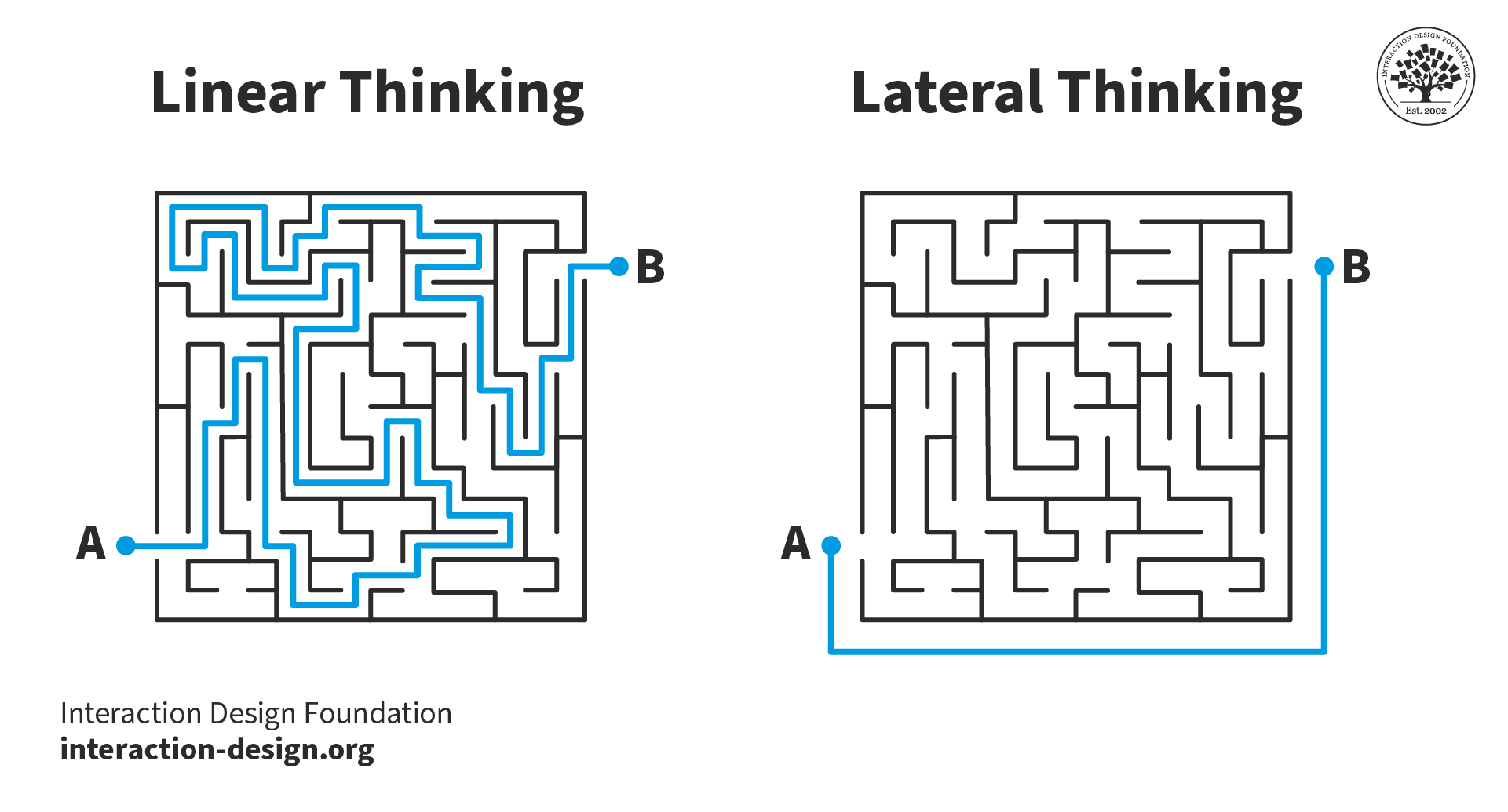
© Interaction Design Foundation, CC BY-SA 4.0
That’s where lateral thinking comes in – essentially thinking outside the box. “The box” refers to the apparent constraints of the design space and our limited perspective from habitually meeting problems head-on and linearly. Designers often don’t realize what their limitations are when considering problems – hence why lateral thinking is invaluable in (e.g.) the design thinking process. Rather than be trapped by logic and assumptions, you learn to stand back and use your imagination to see the big picture when you:
Focus on overlooked aspects of a situation/problem .
Challenge assumptions – to break free from traditional ways of understanding a problem/concept/solution.
Seek alternatives – not just alternative potential solutions, but alternative ways of thinking about problems .
When you do this, you tap into disruptive thinking and can turn an existing paradigm on its head. Notable examples include:
The mobile defibrillator and mobile coronary care – Instead of trying to resuscitate heart-attack victims once they’re in hospital, treat them at the scene .
Uber – Instead of investing in a fleet of taxicabs, have drivers use their own cars .
Rather than focus on channeling more resources into established solutions to improve them, these innovators assessed their problems creatively and uncovered game-changing (and life-changing) insights.
© Interaction Design Foundation, CC BY-SA 3.0
How to Get Fresh Perspectives with Lateral Thinking
For optimal results, use lateral thinking early in the divergent stages of ideation . You want to reframe the problem and:
Understand what’s constraining you and why .
Find new strategies to solutions and places/angles to start exploring .
Find the apparent edges of your design space and push beyond them – to reveal the bigger picture.
You can use various methods. A main approach is provocations : namely, to make deliberately false statements about an aspect of the problem/situation . This could be to question the norms through contradiction, distortion, reversal (i.e., of assumptions), wishful thinking or escapism , for example:
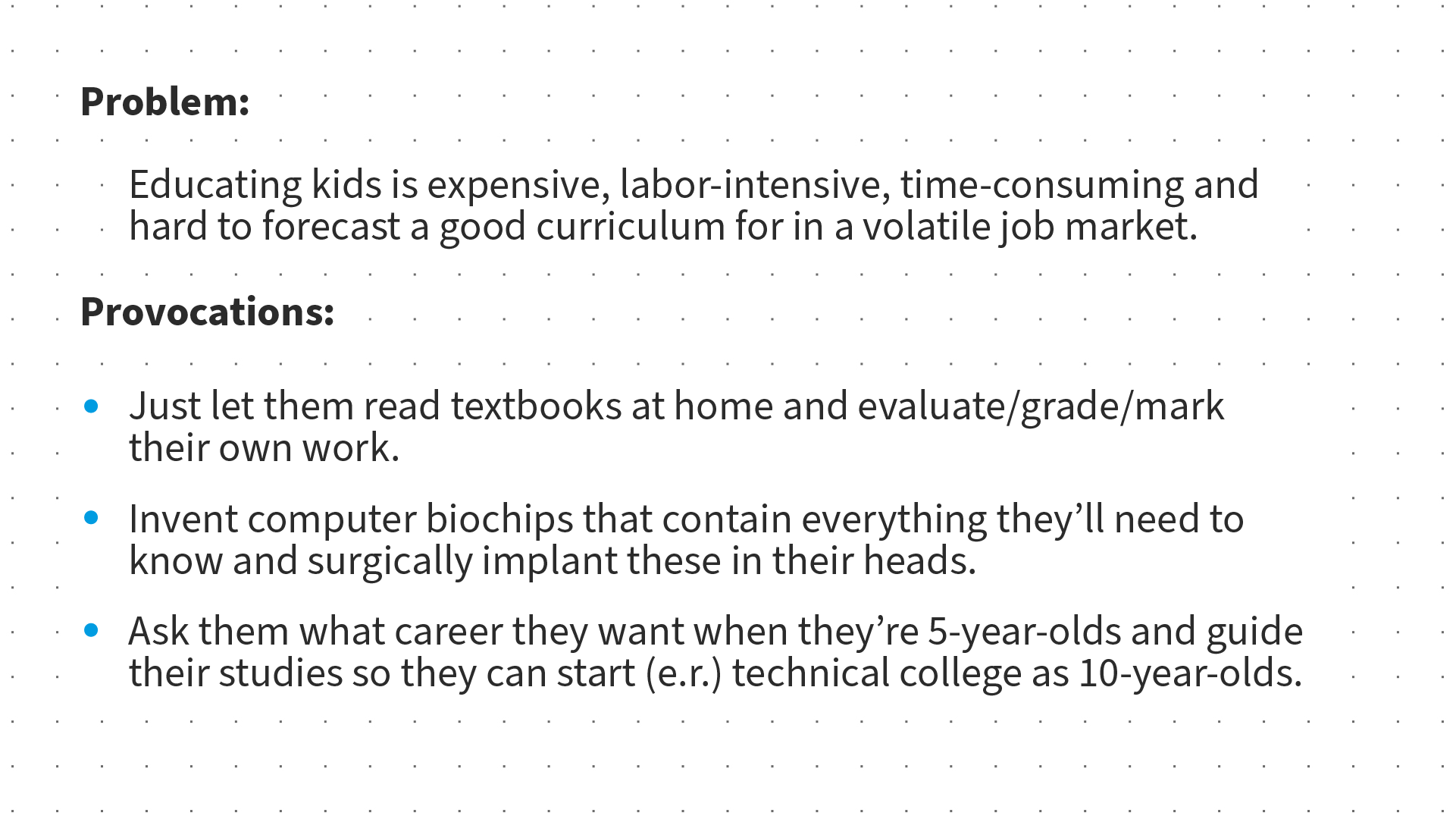
Here, we see the norm of conventional schooling challenged and some unpredictable (and even outrageous) notions to trigger our thinking. Our example showcases this method:
Bad Ideas – You think up as many bad or crazy ideas as possible, but these might have potentially good aspects (e.g., helping children specialize in desired subjects earlier). You also establish why bad aspects are bad (e.g., inserting biochips would be a gross violation of human rights).
Other helpful methods include:
Random Metaphors
Randomly pick an item near you or word from a dictionary and write down as many aspects/associations about it as possible. E.g., “Exhibition” – “visitors walk around enjoying paintings”; “learn about cultures”; “pleasant environment”.
Pretend some genius in your field told you this item/word is a good metaphor for your project. E.g., you can organize information, tips and images for your travel-related app to also act like an art/museum exhibition, so anyone can enjoy an interesting tour of a given location.
Use the metaphors you think of to improve your design/product. E.g., you create a captivating app which virtual tourists can enjoy with (e.g.) virtual reality features.
SCAMPER – To help generate ideas for new solutions, ask 7 different types of questions to help understand how you might innovate and improve existing products, services, concepts, etc. SCAMPER is remarkably easy to learn and efficient in ideation sessions.
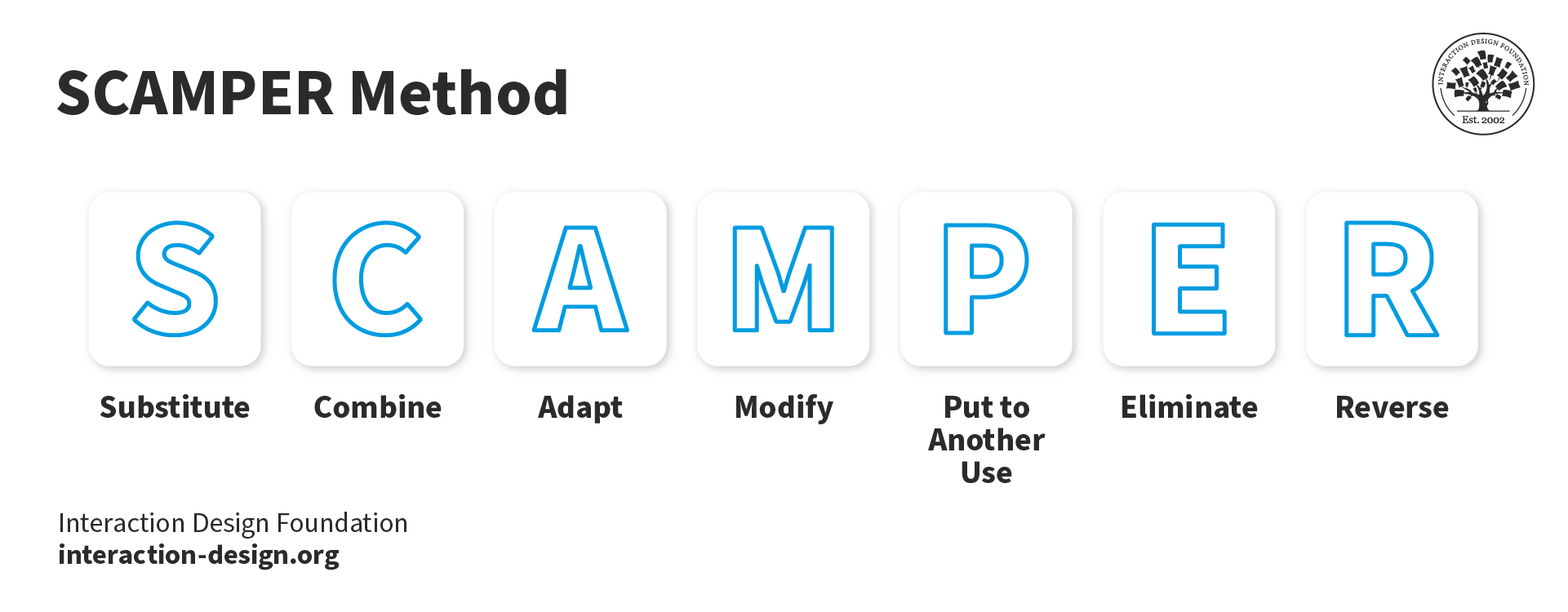
Six Thinking Hats – To reach for alternative viewpoints, you examine problems from 6 perspectives, one at a time (e.g., white hat = focusing on available data; black hat = focusing on potentially negative outcomes).
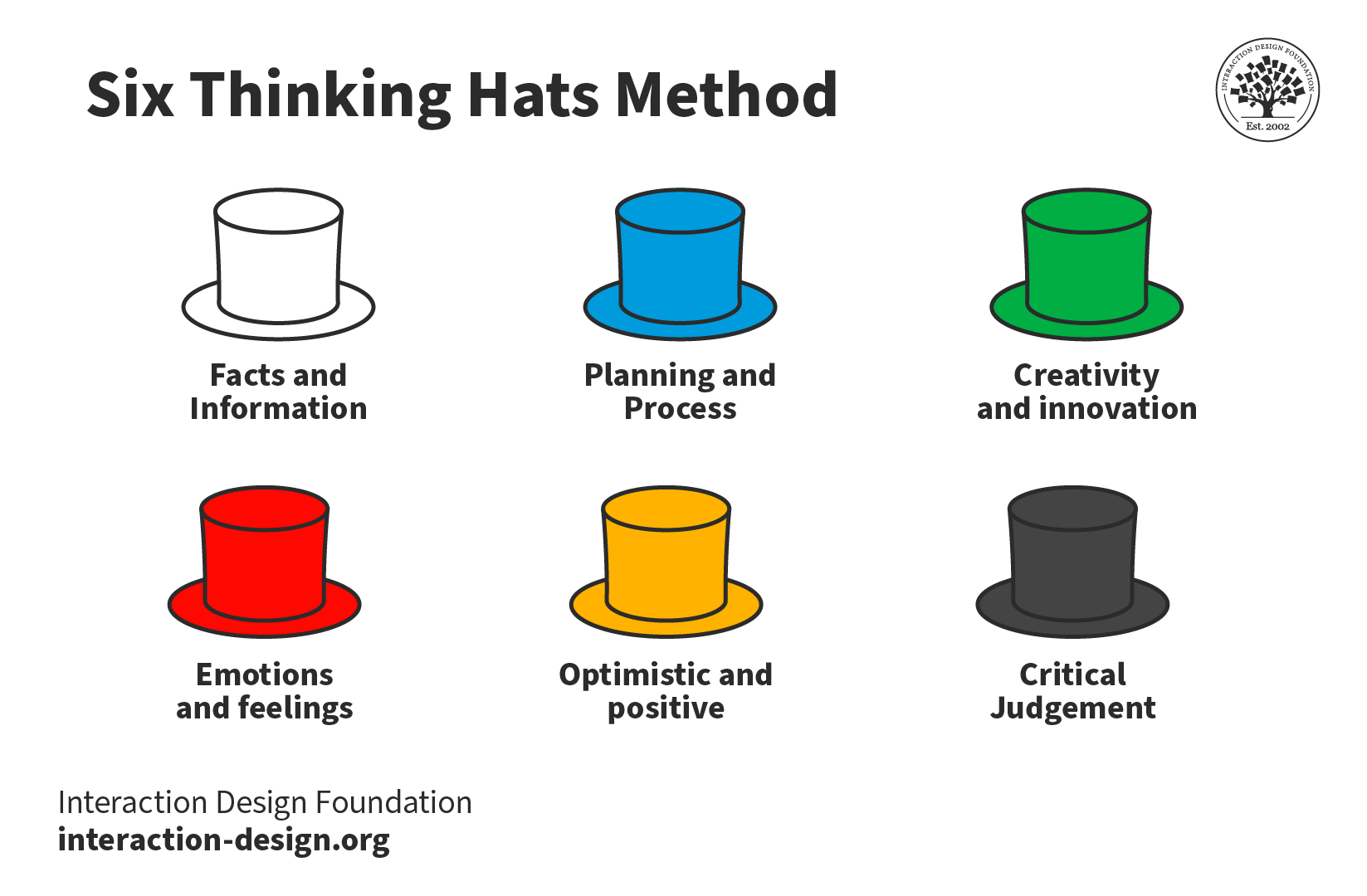
Overall, it’s important to stay aware of where ideation sessions are going. You may need to pause to redirect the group’s thinking or introduce a new trigger/provocation to help the creative process. Later, you use convergent thinking to isolate optimal solutions.
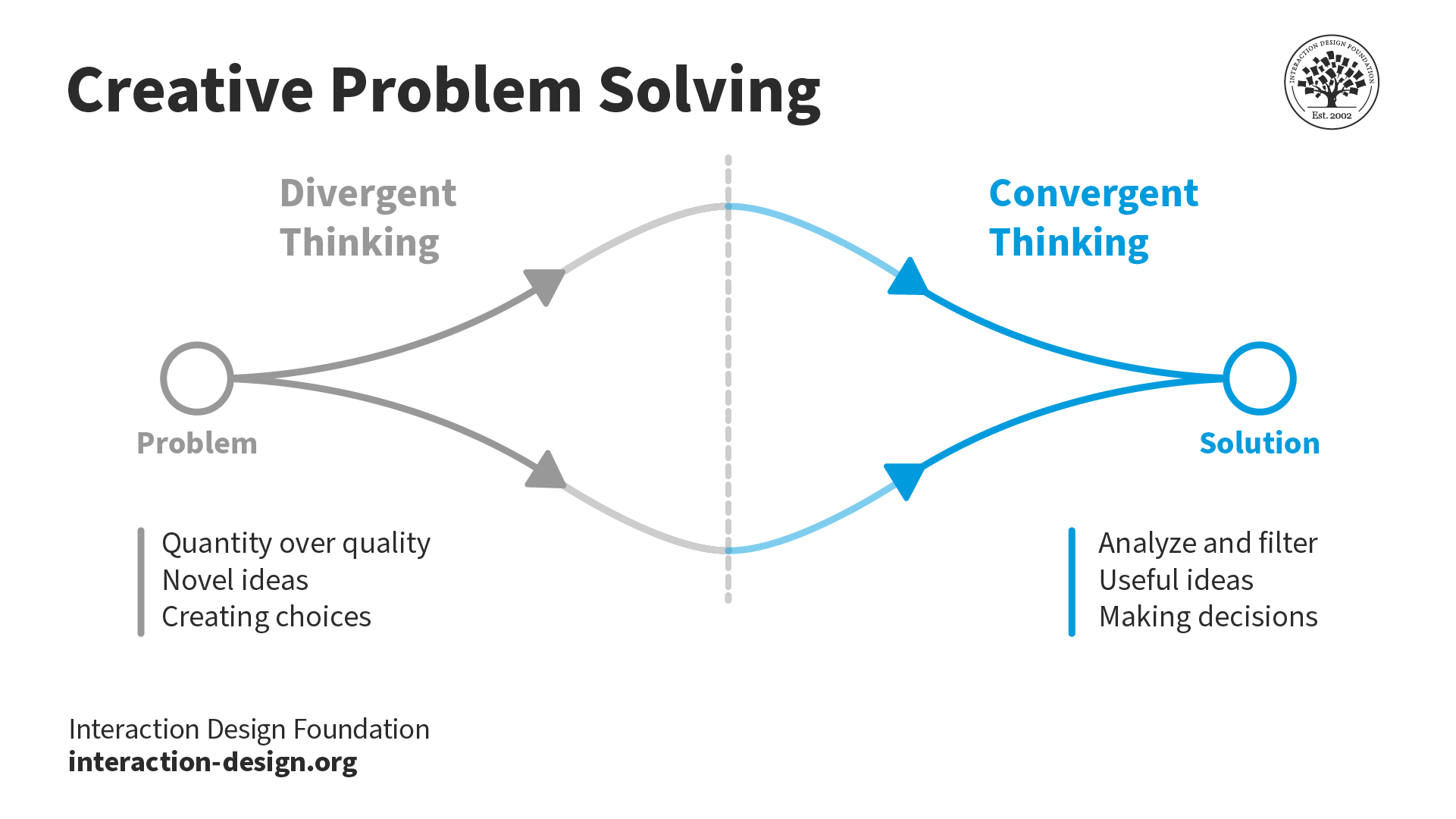
Learn More about Lateral Thinking
Take our Creativity course , featuring lateral thinking.
This thought-provoking Smashing Magazine blog explores l ateral thinking with more techniques .
Read one design team’s insightful account about lateral thinking .
Questions related to Lateral Thinking
Lateral thinking is changing your approach to solve problems or generate new ideas. Take Edward de Bono’s ‘Six Thinking Hats’ as an example of lateral thinking. It involves adopting different roles to approach problems. This video shows how to break free from your usual thinking patterns.
Imagine a person who is generally optimistic. Using the ' black hat ' approach, they could try looking at things negatively. This might help them find new, innovative solutions that they wouldn't have thought of. They can gain a better understanding of the situation by changing their perspective.
The four lateral thinking techniques are:
Provocation : This involves disrupting conventional thinking patterns with unusual ideas.
Challenge : The challenge is about questioning the status quo. It’s about looking at things as if they might be wrong, even if they seem right. This approach encourages deeper analysis and alternative viewpoints.
Random Entry : This technique generates new ideas using a random word or idea as a starting point. It creates connections that may not be immediately noticeable.
Alternatives : It focuses on shifting thinking patterns by exploring various directions and possibilities.
All these techniques encourage thinking outside the box and fostering creativity.
Lateral thinking and linear thinking are two distinct approaches to problem-solving. Linear thinking is sequential and logical. It follows a straight, step-by-step path that relies on data and analysis. It focuses on following the standard path of reasoning going along, as Alan Dix describes it.
Lateral thinking is non-linear. It involves creativity and looking at problems from various angles. It’s about challenging assumptions and exploring unconventional solutions.
Linear thinking concentrates on details and processes. Whereas lateral thinking emphasizes brainstorming and producing innovative ideas. Both are valuable, but they approach problems from different perspectives.
Yes, lateral thinking is a valuable skill. It's a problem-solving approach that stresses creative thinking. Unlike traditional linear thinking, it's about exploring diverse ideas. You can hone this skill through practice, challenging assumptions, making unexpected connections, and approaching problems from fresh angles.
People skilled in lateral thinking are often adept at generating innovative solutions . Many fields, especially those requiring innovation and creativity, value this skill.
Lateral thinking often aligns with intelligence distinct from traditional measures like IQ. Intelligence manifests in various forms, and lateral thinking showcases creative, problem-solving intelligence. Lateral thinkers view things from unique perspectives. They create innovative ideas and link unrelated concepts. This ability marks an essential aspect of creative intelligence.
This video discusses problem redefinition and negotiation in real-world scenarios. Traditional intelligence focuses on finding a single right solution using given information. But lateral thinking is like solving real-world problems. This approach holds significant value in fields that demand innovation and creative problem-solving. Here, Professor Alan Dix discusses
While different from traditional logical thinking, lateral thinking has its logic. It’s not illogical or random. Instead, it follows a distinct reasoning that prioritizes creativity and innovation. Traditional logic is linear and sequential. It focuses on reaching conclusions based on existing knowledge and facts.
Lateral thinking involves looking at problems from new angles and making unexpected connections. Lateral thinking is a creative way of problem-solving. It can help you find unique and practical solutions. Lateral thinking is a powerful tool when conventional logic doesn't work. Check out this video to learn about different types of creativity and what can get in the way of being creative.
- Copyright holder: Bengt Oberger. Appearance time: 2:18 - 2:23 Copyright license and terms: CC-BY-SA-4.0 Link: https://commons.wikimedia.org/wiki/File:Margaret_Boden_01.JPG
- Copyright holder: Niklas Morberg. Appearance time: 5:27 - 5:32 Copyright license and terms: CC BY-SA 2.0 Link: https://www.flickr.com/photos/morberg/3231304833
Lateral thinking and brainstorming are similar yet different. Lateral thinking helps solve problems using creative and unconventional approaches. It breaks away from traditional methods.
Brainstorming is a group activity where people contribute ideas without judgment to solve a problem. It generates creative solutions.
Lateral thinking can be a solitary or group activity and it focuses on thinking differently. It's a specific approach to problem-solving that emphasizes creativity.
Lateral thinking is crucial because it fosters creativity and innovation. It allows you to explore new ideas and solutions that conventional, linear thinking might not reveal. Lateral thinking helps adapt to new challenges and situations. It encourages looking at problems from multiple perspectives. This leads to more comprehensive and sometimes unexpected solutions. This type of thinking is crucial in innovative fields like business, technology, and design.
Lateral thinking breaks from traditional thought patterns and contributes to advancements and breakthroughs. It enhances problem-solving skills and promotes a more dynamic approach to challenges.
Yes, lateral thinking is a form of divergent thinking . Divergent thinking is about spontaneously generating diverse ideas or solutions to a problem. Lateral thinking, a term coined by Edward de Bono, is a specific kind of divergent thinking. It looks at problems from new and unusual angles and seeks innovative solutions outside conventions.
Divergent thinking is a broader concept encompassing various methods of generating creative ideas. Lateral thinking focuses more on breaking conventional patterns and thinking beyond the norm. Both are key in creative processes, encouraging broad exploration of possibilities.
You can take the creativity course featuring lateral thinking to learn more about lateral thinking. This course would be a more in-depth and interactive way to learn. The course will also help develop your lateral thinking skills through practical applications.
Literature on Lateral Thinking
Here’s the entire UX literature on Lateral Thinking by the Interaction Design Foundation, collated in one place:
Learn more about Lateral Thinking
Take a deep dive into Lateral Thinking with our course Creativity: Methods to Design Better Products and Services .
The overall goal of this course is to help you design better products, services and experiences by helping you and your team develop innovative and useful solutions. You’ll learn a human-focused, creative design process.
We’re going to show you what creativity is as well as a wealth of ideation methods ―both for generating new ideas and for developing your ideas further. You’ll learn skills and step-by-step methods you can use throughout the entire creative process. We’ll supply you with lots of templates and guides so by the end of the course you’ll have lots of hands-on methods you can use for your and your team’s ideation sessions. You’re also going to learn how to plan and time-manage a creative process effectively.
Most of us need to be creative in our work regardless of if we design user interfaces, write content for a website, work out appropriate workflows for an organization or program new algorithms for system backend. However, we all get those times when the creative step, which we so desperately need, simply does not come. That can seem scary—but trust us when we say that anyone can learn how to be creative on demand . This course will teach you ways to break the impasse of the empty page. We'll teach you methods which will help you find novel and useful solutions to a particular problem, be it in interaction design, graphics, code or something completely different. It’s not a magic creativity machine, but when you learn to put yourself in this creative mental state, new and exciting things will happen.
In the “Build Your Portfolio: Ideation Project” , you’ll find a series of practical exercises which together form a complete ideation project so you can get your hands dirty right away. If you want to complete these optional exercises, you will get hands-on experience with the methods you learn and in the process you’ll create a case study for your portfolio which you can show your future employer or freelance customers.
Your instructor is Alan Dix . He’s a creativity expert, professor and co-author of the most popular and impactful textbook in the field of Human-Computer Interaction. Alan has worked with creativity for the last 30+ years, and he’ll teach you his favorite techniques as well as show you how to make room for creativity in your everyday work and life.
You earn a verifiable and industry-trusted Course Certificate once you’ve completed the course. You can highlight it on your resume , your LinkedIn profile or your website .
All open-source articles on Lateral Thinking
Learn how to use the worst possible idea method.

Understand the Elements and Thinking Modes that Create Fruitful Ideation Sessions
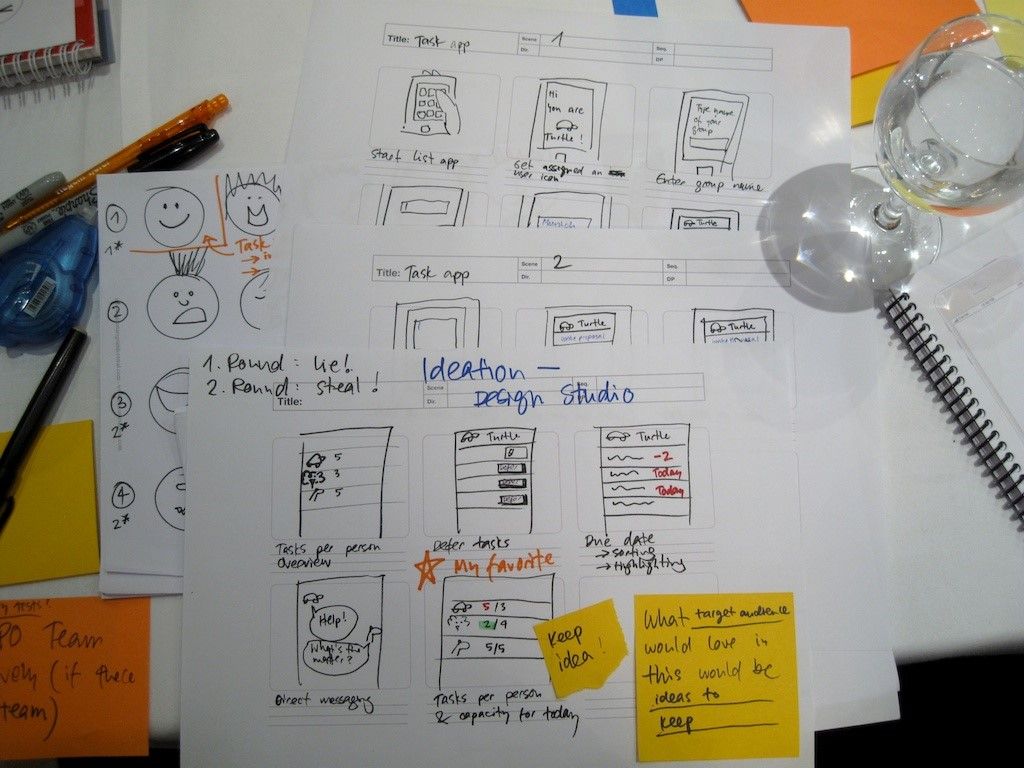
- 3 years ago
Open Access—Link to us!
We believe in Open Access and the democratization of knowledge . Unfortunately, world-class educational materials such as this page are normally hidden behind paywalls or in expensive textbooks.
If you want this to change , cite this page , link to us, or join us to help us democratize design knowledge !
Privacy Settings
Our digital services use necessary tracking technologies, including third-party cookies, for security, functionality, and to uphold user rights. Optional cookies offer enhanced features, and analytics.
Experience the full potential of our site that remembers your preferences and supports secure sign-in.
Governs the storage of data necessary for maintaining website security, user authentication, and fraud prevention mechanisms.
Enhanced Functionality
Saves your settings and preferences, like your location, for a more personalized experience.
Referral Program
We use cookies to enable our referral program, giving you and your friends discounts.
Error Reporting
We share user ID with Bugsnag and NewRelic to help us track errors and fix issues.
Optimize your experience by allowing us to monitor site usage. You’ll enjoy a smoother, more personalized journey without compromising your privacy.
Analytics Storage
Collects anonymous data on how you navigate and interact, helping us make informed improvements.
Differentiates real visitors from automated bots, ensuring accurate usage data and improving your website experience.
Lets us tailor your digital ads to match your interests, making them more relevant and useful to you.
Advertising Storage
Stores information for better-targeted advertising, enhancing your online ad experience.
Personalization Storage
Permits storing data to personalize content and ads across Google services based on user behavior, enhancing overall user experience.
Advertising Personalization
Allows for content and ad personalization across Google services based on user behavior. This consent enhances user experiences.
Enables personalizing ads based on user data and interactions, allowing for more relevant advertising experiences across Google services.
Receive more relevant advertisements by sharing your interests and behavior with our trusted advertising partners.
Enables better ad targeting and measurement on Meta platforms, making ads you see more relevant.
Allows for improved ad effectiveness and measurement through Meta’s Conversions API, ensuring privacy-compliant data sharing.
LinkedIn Insights
Tracks conversions, retargeting, and web analytics for LinkedIn ad campaigns, enhancing ad relevance and performance.
LinkedIn CAPI
Enhances LinkedIn advertising through server-side event tracking, offering more accurate measurement and personalization.
Google Ads Tag
Tracks ad performance and user engagement, helping deliver ads that are most useful to you.
Share the knowledge!
Share this content on:
or copy link
Cite according to academic standards
Simply copy and paste the text below into your bibliographic reference list, onto your blog, or anywhere else. You can also just hyperlink to this page.
New to UX Design? We’re Giving You a Free ebook!

Download our free ebook The Basics of User Experience Design to learn about core concepts of UX design.
In 9 chapters, we’ll cover: conducting user interviews, design thinking, interaction design, mobile UX design, usability, UX research, and many more!

Microsoft 365 Life Hacks > Organization > Lateral and vertical thinking for problem solving
Lateral and vertical thinking for problem solving
Are you looking for new ways to solve problems and navigate the challenges that come your way? Lateral and vertical thinking can help you do just that. These solutions are like two sides of the same coin, often working in harmony to solve problems. Whether you’re a lateral or vertical thinker, understanding these concepts can revolutionize the way you approach challenges and help you implement impactful new solutions.

What is lateral thinking?
Imagine the problem at hand as a maze with countless pathways that lead to the answer. Lateral thinking is the art of exploring the unconventional pathways to find the less-obvious solutions. It’s all about thinking outside the box, breaking free from your usual thought patterns, and embracing creativity to generate ideas .
Are you a lateral thinker?
Lateral thinking encourages you to approach problems from multiple angles to boost your creativity. Instead of following a linear path, lateral thinkers jump between concepts to find hidden connections that they can turn into ideas. This approach is particularly valuable when faced with questions that don’t have obvious answers.
What is vertical thinking?
While lateral thinking takes a creative and indirect approach to solving problems, vertical thinking is more linear. It’s used to solve well-defined problems that require a systematic and logical approach. Vertical thinking also involves analyzing information and following a structured path to reach a solution.

All your ideas in one place
Keep your thoughts, content, and lists handy with OneNote
Are you a vertical thinker?
Vertical thinking works best in situations where clarity and precision are needed. Vertical thinkers use their analytical skills to break down complex issues into manageable steps that they can methodically work through. They also excel at solving problems through a structured, efficient approach .
Combining lateral and vertical thinking
While you may favor one method over another, lateral and vertical thinking aren’t mutually exclusive. In fact, many successful problem-solvers use a combination of both for the best results. Using lateral and vertical thinking in tandem helps you adapt your strategy to any problem. Lateral thinking encourages creativity and innovation, while vertical thinking provides structure and precision where additional clarity is needed.
To become a master problem solver, you don’t need to choose between lateral or vertical thinking. Instead, recognize the strengths of each approach and use them as needed. When faced with a complex challenge, start by thinking laterally to generate fresh ideas and possibilities. Next, transition into vertical thinking to refine your solution and take the subsequent steps. These complementary styles can help you effectively tackle a wide range of challenges and navigate problems with creativity and precision.
Get started with Microsoft 365
It’s the Office you know, plus the tools to help you work better together, so you can get more done—anytime, anywhere.
Topics in this article
More articles like this one.

How to run an effective project kickoff meeting
Learn what a project kickoff meeting is and how you can run one.

Eight corporate buzzwords you need to know
Learn corporate buzzwords with this guide to office slang.

What is macromanagement?
Macromanagement stands in stark contrast to micromanagement. See how it focuses on providing a broader perspective through trust and progress.

How to organize your desk for maximum productivity

Everything you need to achieve more in less time
Get powerful productivity and security apps with Microsoft 365

Explore Other Categories

Unsolved Mysteries: Problem-Solving with Lateral Thinking
Four lateral thinking techniques to help you get “outside the box”.
Have you ever encountered an unsolvable problem? One where, no matter how much you pound on it, the solution never presents itself?
This reminds me of an old TV show, Unsolved Mysteries (recently rebooted by Netflix). Over some dramatic theme music, we would see re-enactments of mysterious events, such as people disappearing, cars being shot, and other sensational incidents, followed by the host asking viewers to help solve this seemingly unsolvable mystery.
Sometimes you can turn to others for help in solving a mystery, but often you have to figure it out yourself. When you don’t have Robert Stack (one of the hosts of Unsolved Mysteries ) to call on, try changing your approach and use lateral thinking .
What Is Lateral Thinking?
Lateral thinking foregoes the usual step-by-step approach to problem-solving and instead uses indirect and creative approaches to come up with solutions that aren’t immediately obvious. In essence, it encourages you to think creatively, write down any ideas you come up with no matter how outlandish, and access different parts of your brain to help you solve a problem. It’s a different take on “out-of-the-box” thinking.
I ran into an unsolvable problem recently while working on a database conversion project. No matter what I did, the new database refused to connect to the system. I used all the tried-and-true methods to solve the issue — checked my steps, reached out to co-workers — but the problem remained unsolved. I finally turned to lateral thinking to come up with new solutions.
I took out a piece of paper and drew a picture of the database and the system, and left space between them. In the space, I brainstormed a variety of ways — some of them pretty out there — to get the database and the system to talk to each other. The emphasis was on coming up with ideas and not worrying about issues with implementing them. From there, I circled the ones I wanted to try. This led to more thinking, and eventually I solved the problem. The solution seems obvious now, but at the time, it was a deep mystery to me.
Lateral Thinking Techniques
Edward de Bono, who originated the concept of lateral thinking, lists four techniques 1 for helping develop this ability:
- Awareness . Being aware of how you process information is the first step to improving your lateral thinking.
- Random stimulation. Rather than shut out outside influences, allow intrusions to help encourage your creativity.
- Alternatives. Even if there’s a perfectly obvious solution, sometimes it helps to put it aside and come up with alternative approaches.
- Alteration. Break down relationships between elements, deny things you take for granted, and really challenge the elements of a problem. This can help to produce new solutions to the problem.
The next time you encounter an unsolvable mystery, try lateral thinking. Ask yourself, how will you apply this technique to help you solve a problem? How can you use the four techniques to literally think outside the box?
1 Information Processing and New Ideas — Lateral and Vertical Thinking . Edward de Bono, 1969
Further Reading:
- Lateral Thinking ( https://www.edwddebono.com/lateral-thinking )
- The most undervalued skill? Lateral thinking. ( https://bigthink.com/mind-brain/lateral-thinking )
- The Top Ten Lateral Thinking Problems . ( https://www.destination-innovation.com/the-top-ten-lateral-thinking-puzzles/ )
- Career Development , Miscellaneous , Performance Improvement
2 Responses
Great blog, Walter! The ability to look at a problem from more than one perspective is so important. Also challenging ourselves and others to push through, as you did, on a problem that seems unsolvable. Thank you for this challenge. I’m looking forward to checking out the further reading suggestions, too.
Excellent. I have myself tried lateral thinking in hospital management, successfully. But, since we have never been taught anything other than vertical thinking since childhood, we find it difficult to accept that lateral thinking can be very useful in problem solving.
Leave a Reply Cancel reply
Your email address will not be published. Required fields are marked *
Save my name, email, and website in this browser for the next time I comment.
21 Lateral Thinking Examples (And Definition)

The term lateral thinking refers to a problem-solving strategy that utilizes creative and indirect reasoning. We might colloquially call it “thinking outside the box.’
Instead of relying on step-by-step analysis of the problem, the conventional method, lateral thinking often produces solutions that only seem obvious in hindsight.
The term “lateral thinking” was coined by Edward de Bono (1967) in his book The Use of Lateral Thinking .
He illustrates the difference between lateral thinking and conventional logic-based thinking (referred to as vertical thinking) with the following lateral thinking example:
“If you were to take a set of toy blocks and build them upwards, each block resting firmly and squarely on the block below it, you would have an illustration of vertical thinking. With lateral thinking the blocks are scattered around. They may be connected to each other loosely or not at all. But the pattern that may eventually emerge can be as useful as the vertical structure” (p. 11).
Lateral thinking can be applied to any problem and is often seen in professions such as advertising and product design, where creativity is highly valued.
11 Top Lateral Thinking Examples
- Finding Alternatives: Using a car engine to generate electricity in your home during a blackout
- Working Around Problems: Starting a business when you are having trouble getting a job
- Generating Tech Solutions: Using a drone to deliver packages instead of a traditional delivery truck
- Reverse Thinking: Instead of thinking about what you want to achieve, think about what you don’t want to achieve, and find ways to avoid it.
- Seeking New Solutions: Using virtual reality technology for mental health treatment to save time and money
- Seeing Opportunity in Disaster: Using mobile apps for remote learning and education during a lockdown
- Finding a Way: Using crowdfunding to finance small business and startup projects
- Creating New Avenues: Using the sharing economy such as Airbnb and Uber to make use of underutilized resources
- Being Resourceful: Using green roofs and walls for urban agriculture and sustainable building design
- Thinking Outside the Box: Using a magnifying glass to light a fire when you realize you don’t have matches or a lighter (this is the inverse of functional fixedness )
- Divergent Thinking : Using a coconut shell as a bowl because you don’t have any bowls nearby
10 Lateral Thinking Case Studies
1. goal: make more money.
Lateral thinking involves reframing the problem in a way that allows us to see a solution that would not be seen with conventional vertical thinking.
For example, if the problem is that you want to make more money, the logic-based vertical thinking solution leads to a very logical solution: work more.
Working more means more money will be transferred to your possession; problem solved.
Unfortunately, this solution can lead to a person taking multiple jobs and working nearly every waking moment of their existence. Yes, this will generate more money. But at what expense?
Lateral thinking suggests reframing of the problem: save more money. This results in more money being in your pocket, which is the ultimate goal.
However, instead of working three jobs, the lateral solution is to spend less money. Stop buying over-priced coffee and instead purchase a good coffee maker. Instead of buying a new car, buy one second-hand.
2. The Fearless Girl
Lateral thinking can be seen in some of the most clever marketing campaigns in history. Often, the ad is amazingly simple, yet powerful. The simplicity adds to its impact.
One example can be seen in the marketing campaign known as The Fearless Girl by State Street Global Advisors.
Instead of implementing the usual strategy of producing TV ads with a respected spokesperson or having short scenes of testimonials from average citizens that have had great financial success investing in stocks, they took a quite creative approach.
They hired Kristen Visbal to sculpt a bronze figure of a young female child standing boldly, hands on hips, and placed her directly in front of the quite large and intimidating Charging Bull in the financial district of Manhattan in New York City.
The goal was to advertise an index fund which was focused on gender diverse companies that have a high percentage of women in senior leadership. That index fund is represented by the ticker symbol SHE.
3. Measuring Income Inequality
Economic equality is recognized as the source of many ills in the world today. From civil unrest to the dysfunctional family unit, when humans feel as though they do not have economic opportunity, while others live lavishly, many troubles will ensue.
The vertical thinking approach to measuring economic inequality involves a mathematical formula consisting of various economic and population indexes.
In his seminal paper (Atkinson, 1970) states that the “…conventional method of approach is misleading….I hope that these conventional measures will be rejected in favor of direct consideration of the properties that we should like the social welfare function to display” (p. 262)
He then took an unusual approach to measuring the concept by including social welfare issues. In his own words:
“Lateral thinking led to the results on the measurement of risk being applied to the problem of measuring income inequality. In this, and in other areas of economics, lateral thinking has made a significant contribution” (Atkinson, 2011, p. 319).
His use of lateral thinking has had a profound impact in economics, demonstrating that “…economics is primarily a social and moral science” (Wernerová, 2019, p. 1).
4. Challenging Assumptions: The Nine Dots Problem
The nine dots problem is well-known to most readers. Nonetheless, it is offered by de Bono (1970) as an example of how lateral thinking is accomplished by challenging assumptions.
As de Bono explains:
“In challenging assumptions, one challenges the necessity of boundaries and limits and one challenges the validity of individual concepts. As in lateral thinking in general there is no question in attacking the assumptions as wrong…It is simply a matter of trying to restructure patterns. And by definition, assumptions are patterns which usually escape the restructuring process” (p. 49).
The problem goes like this: Nine dots are arranged in three vertical rows of three. The goal is to connect the nine dots using only four straight lines, without raising the pencil from the paper.
The solution is derived by letting go of the common assumption that one cannot extend the line past the outer boundaries of the dots. Although this rule is never stated in the instructions, people have this assumption fixed in their mind.
“If one breaks through this assumption and does go beyond the boundary then the problem is easily solved…” (p. 50).
Read more about challenging assumptions in this article.
5. In the Classroom
In many of his books, de Bono likes to use classroom examples of how teachers can help their students develop lateral thinking. This is a noble cause and one reason that his work has had such an enduring impact in the study of problem-solving , divergent thinking, and creativity.
One exercise he recommends is for teachers to ask students to design a useful product. Some specific suggestions include:
- an apple-picking machine
- a cup that cannot spill
- a device to help cars park
The purpose of this activity is to show that there can be different solutions to the same problem. It is the thinking process that is so much more valuable than the end result.
“Though an idea may seem silly in itself it can still lead to something useful…No one is silly for the sake of being silly no matter how it might appear to other people. There must be a reason why something made sense to the person who drew it at the moment when it was drawn. What it appears to other people is not so important if one is trying to encourage lateral thinking. In any case whatever the reason behind a design and however silly it may be it can still be a most useful stimulus to further ideas” (de Bono, 1970, p. 61).
6. Reconceptualizing the Good Life
Some people in Western cultures start to feel a great deal of stress as a result of constantly striving to have a better life. They believe that having material objects such as a big house with a three-car garage, dining in over-priced restaurants, and wearing expensive jewelry are signs of living the good life.
This is typical vertical thinking that is defined culturally. Possessing expensive material goods equals a better life.
However, lateral thinking would change the definition of “better life.” With lateral thinking, the concept is defined as feeling relaxed, leading a slower pace of life, and spending time on hobbies.
So, the solution is simple, and many people have taken this step. Instead of working harder to purchase more material goods, they sell all they have and move to a country with a much lower cost of living.
Many Americans have done just that. For example, many Californians are selling their houses (known for expensive real estate) and moving to small beach towns in Mexico.
They arrive at the solution they want: to have a better life, but do so by escaping conventional norms through lateral thinking and taking a different path.
7. The Best TV Ad in History
Yes, crowning something as “best in history” is not an exact science. It’s a value judgment that is subjective and open to a lot of debate. However, there is no doubt that at least one of the best TV ads in history is the 1984 ad by Apple .
It was a groundbreaking piece of cinematography for a TV ad, produced by Ridley Scott, the director of Blade Runner.
The reason the ad is considered so astounding is more than just the visual aesthetics, but has a lot more to do with the message. Instead of relying on vertical thinking and boasting about the computing power or the advanced graphics chip, the ad says nothing about those features.
The ad is an exercise in lateral thinking like never before seen in the advertising world. It makes a statement about conformity, bucking the establishment, and avid individualism.
8. The “Why” Technique
The “why” lateral thinking technique by de Bono is designed to create discomfort with the information that has been provided. The process involves the teacher making a statement, followed by the student asking “why.” This exchange is repeated at length; each explanation to be questioned.
“The usual purpose of “why” is to elicit information. One wants to be comforted with some explanation which one can accept and be satisfied with. The lateral use of why is quite opposite. The intention is to create discomfort with any explanation. By refusing to be comforted with an explanation one tries to look at things in a different way and so increases the possibility of restructuring the pattern” (de Bono, 1970, p. 53).
The process is a little more complex if done properly. Rather than simply repeating the word “why,” much like the habit of a child, the serious student will be more focused. The question should be directed to a specific aspect of the previous explanation.
Even if the teacher knows of the true reason, to get the most out of this exercise, they should phrase their answer that allows enough flexibility to continue the probe.
9. Applied to Students
Srikongchan et al. (2021) pointed out that many instructional approaches in the classroom fail to foster creativity in school children.
Students “…are directed to think in the same pattern to understand the contents, working the projects, and generating the solutions. They are not encouraged to think differently or think out of the box” (p. 234).
The researchers implemented a backward instructional design by having students participate in 9 different lateral thinking learning activities.
A total of 60 fifth-grade students in an Information Technology course in Thailand took part in the study, and their degree of creativity was assessed both before and after the lateral thinking activities.
The results indicated that students:
“…significantly improved their creative thinking scores” when comparing before and after scores. “ It can be implied that the learning activities and learning experience of lateral thinking could provide students a meaningful learning process …and help the students developed creative thinking ” (p. 243).
10. The Reverse Thinking Technique
At the center of lateral thinking is the objective to look at a problem from a different perspective. The reversal technique takes similar aim.
The process leads to a way of looking at a situation that is obviously wrong, perhaps even ridiculous. This is done to escape the shackles of conventional vertical thinking.
For instance, the teacher explains that a policeman directs traffic. Then, the students are instructed to engage in reverse thinking, which leads to: the traffic controls the policeman, or, the policeman disorganizes the traffic.
This leads to a consideration of natural traffic flow, or if traffic lights would be superior to a policeman.
It doesn’t matter if the solution generated actually makes sense in the beginning; the point is that the student/problem-solver is moving in the right direction. The purpose is to be provocative and to consider the problem from an alternative point of view.
Lateral Thinking Strengths
1. discovering overlooked ideas.
One of the most valuable strengths of lateral thinking is the consideration of overlooked aspects of a problem.
Because people are so locked-in to vertical thinking, which is logical and rational, they can fail to see all aspects of a situation.
Lateral thinking encourages the examination of all aspects of a matter. Even if those elements seem inconsequential, one never knows how valuable they may be unless they are at least considered.
2. Generating a Different Perspective
Several of the techniques utilized in lateral thinking have the explicit goal of looking at a problem from a different perspective.
This is at the heart of divergent thinking or creativity, or the oft-overused saying “think outside the box.”
“In lateral thinking one is not looking for the right answer but for a different arrangement of information which will provoke a different way of looking at the situation” (de Bono, 1970, p. 71).
Even if that different way of looking seems silly and invaluable, it may actually lead to someone else having a great idea that is the exact solution needed.
3. Constructively Challenge the Status Quo
Challenging the status quo enables the problem-solver to generate useful solutions.
So often people become used to using a product a certain way or going through a procedure in a specific manner. Those routines can become so automatic that they are just accepted as standard operating procedures.
However, the techniques of lateral thinking force people to question those givens and seek alternatives.
By challenging the assumptions of why we do the things we do, we take the first step to creating a better process, which may be more efficient or may actually be a complete overhaul of standard practices.
See More: Status Quo Examples
Lateral Thinking Weaknesses
1. conceptual redundancy.
Lateral thinking has quite a bit in common with divergent thinking, innovation, and creativity.
These concepts all involve looking at situations from a different perspective and generating solutions that are unique and non-conventional.
Since there is so much overlap in these very similar concepts, one has to wonder why is there a need to invent a new term for those that already exist?
If divergent thinking and lateral thinking result in the same unique solution, then why is there a need to have two names for the same horse?
2. Fails to Acknowledge Research
One weakness of lateral thinking is that de Bono often ignores established research on thinking and problem-solving.
There has been a tremendous amount of rigid scientific research on heuristics, divergent thinking, and methods to improve problem-solving.
However, that research is unacknowledged, not even mentioned in de Bono’s many books.
To be accepted as a scientific theory, it is necessary to explain how one’s own postulations fit with other theories, particularly those theories that have earned wide acceptance due to the body of solid science behind them.
3. Reliance on Riddles, Stories, and Testimonials
Lateral thinking has been termed a “ pseudoscience ” (or, more specifically, pseudo-psychology ) by critics. Because of its reliance on riddles, fictional stories, and testimonials as support for the theory’s efficacy, it fails to meet standard criteria for legitimacy.
Although de Bono offers-up narratives as illustrating key concepts in lateral thinking, it is not the kind of evidence that is considered valid in disciplines such as modern psychology.
As Antonio Melechi succinctly concluded :
“Rather than accumulate independent empirical evidence of its efficacy, the lateral thinking movement still opts to festoon itself in anecdotes, hearsay and testimonials.”
Lateral thinking involves approaching problems in ways that result in a novel solution. Instead of taking the usual path of conventional problem-solving methods such as logic, the theory postulates that lateral thinking offers a valuable alternative.
There are several techniques presented by de Bono (1967; 1970) that facilitate lateral thinking and the generation of novel solutions. These techniques involve questioning the assumptions of the problem, challenging the usual explanations by asking “why,” and engaging in reverse thinking.
Lateral thinking can result in discovering previously overlooked aspects of a problem, helping people see the problem from a different perspective, and challenging accepted practices and conceptions.
On the other side of the coin, critics would like to see the theory supported by empirical evidence and a clear explanation of how it differs from theories that have solid scientific support.
Atkinson, A. B. (1970). On the measurement of inequality. Journal of Economic Theory, 2, 244-263.
Atkinson, A. B. (2011). On lateral thinking. The Journal of Economic Inequality, 9(3), 319-328.
de Bono, E. (1967). The use of lateral thinking. Jonathan Cape
de Bono, E. (1977). Lateral Thinking: a textbook of creativity. Penguin Books.
Srikongchan, W., Kaewkuekool, S., & Mejaleurn, S. (2021). Backward instructional design based learning activities to developing students’ creative thinking with lateral thinking technique. International Journal of Instruction , 14 (2), 233-252.
Wernerová, Barbora. (2019). Economic inequality according Atkinson. SHS Web of Conferences, 61. 01034. https://doi.org/10.1051/shsconf/20196101034

Dave Cornell (PhD)
Dr. Cornell has worked in education for more than 20 years. His work has involved designing teacher certification for Trinity College in London and in-service training for state governments in the United States. He has trained kindergarten teachers in 8 countries and helped businessmen and women open baby centers and kindergartens in 3 countries.
- Dave Cornell (PhD) https://helpfulprofessor.com/author/dave-cornell-phd/ 25 Positive Punishment Examples
- Dave Cornell (PhD) https://helpfulprofessor.com/author/dave-cornell-phd/ 25 Dissociation Examples (Psychology)
- Dave Cornell (PhD) https://helpfulprofessor.com/author/dave-cornell-phd/ 15 Zone of Proximal Development Examples
- Dave Cornell (PhD) https://helpfulprofessor.com/author/dave-cornell-phd/ Perception Checking: 15 Examples and Definition

Chris Drew (PhD)
This article was peer-reviewed and edited by Chris Drew (PhD). The review process on Helpful Professor involves having a PhD level expert fact check, edit, and contribute to articles. Reviewers ensure all content reflects expert academic consensus and is backed up with reference to academic studies. Dr. Drew has published over 20 academic articles in scholarly journals. He is the former editor of the Journal of Learning Development in Higher Education and holds a PhD in Education from ACU.
- Chris Drew (PhD) #molongui-disabled-link 25 Positive Punishment Examples
- Chris Drew (PhD) #molongui-disabled-link 25 Dissociation Examples (Psychology)
- Chris Drew (PhD) #molongui-disabled-link 15 Zone of Proximal Development Examples
- Chris Drew (PhD) #molongui-disabled-link Perception Checking: 15 Examples and Definition
Leave a Comment Cancel Reply
Your email address will not be published. Required fields are marked *
Enter store using password:
Opening soon.
Be the first to know when we launch.
- Opens in a new window.

Lateral Thinking for Problem-Solving: Find the Haystack!
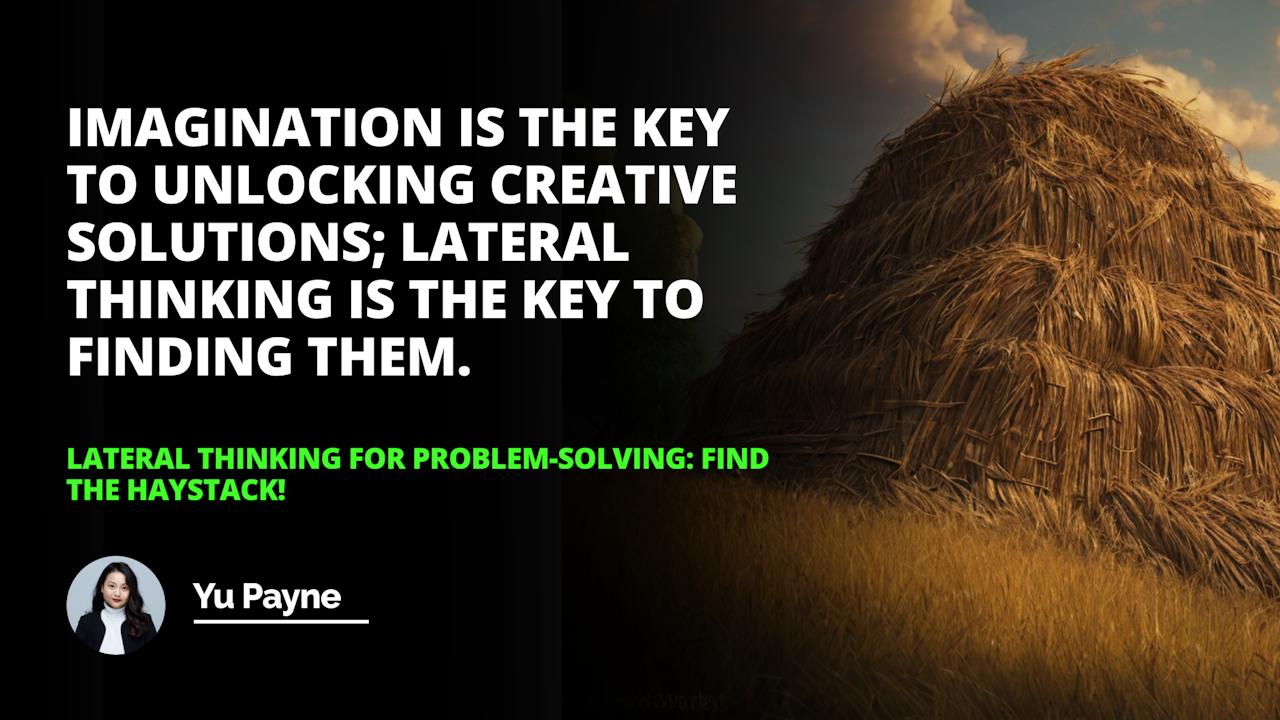
This article discusses lateral thinking, a problem-solving technique that encourages creative solutions by looking at a problem differently. It explains the role of lateral thinking in problem-solving and how it can be used to find the needle in the haystack.
It encourages creative thinking by challenging traditional ways of thinking and finding solutions and is often used in business and educational settings. The article provides examples of lateral thinking, such as digging a hole and researching cancer, to illustrate the concept. It also discusses the need for lateral thinking when finding the needle in the haystack and how it can help you find it by looking at the problem from a different angle and considering different approaches to solving it.
Introduction
Definition of Lateral Thinking
Overview of problem-solving, lateral thinking and problem-solving, digging a hole.
Problem-solving is an integral part of everyday life. We are constantly presented with problems that require creative solutions. Lateral thinking is a problem-solving technique that can help us find solutions to complex problems. In this article, we will discuss the definition of lateral thinking, its role in problem-solving, and the need for lateral thinking when finding the needle in the haystack.
Lateral thinking is a problem-solving technique that encourages creative solutions to problems. It involves looking at a problem from a different angle and coming up with a solution that is not immediately obvious. It encourages creative thinking by challenging traditional ways of thinking and finding solutions. It is often used in business and educational settings to help people think outside the box and develop new, innovative solutions.
Problem-solving is the process of finding a solution to a problem. It involves analyzing the problem, identifying potential solutions, and evaluating and selecting the best solution. Problem-solving can be done individually or as a group. It is an essential skill for success in many areas of life, such as business, education, and personal relationships.
Root Cause Tree Analysis: Insights to Forensic Decision Making
Limit Feedback Sessions: Boost Decision-Making Efficacy
Process Mapping: A Comprehensive Guide to Efficient Workflow Management
Problem Management: A Guide to Change Success
The metaphor of digging a hole is often used to illustrate the concept of lateral thinking. If you have been digging a hole in a particular thinking and problem-solving domain for a long time, you have made the hole more profound and comprehensive.
At some point, you may decide to start digging in another location, a lateral location. This is the concept of lateral thinking. It involves looking at the problem from a different angle and coming up with a solution that is not immediately obvious.
Researching Cancer
Another example of lateral thinking is when researching the field of cancer. If you have been focusing on radiation treatment for prostate cancer, you may switch to a different, lateral approach. This could be chemotherapy, immunotherapy, or surgical therapy. Lateral thinking encourages you to consider different approaches to a problem rather than sticking to the same old methods.
The Needle in the Haystack
Finding the haystack.
The metaphor of the needle in the haystack is often used to illustrate the difficulty of finding a solution to a problem. In this case, the needle is the solution, and the haystack is the problem. Finding the solution requires creative thinking and lateral thinking. Simply looking for the needle is not enough; you must also find the haystack.
Lateral Thinking as a Solution
Lateral thinking can help you find the haystack. It encourages you to look at the problem from a different angle and consider different approaches to solving it. It also encourages you to think outside the box and come up with creative solutions. It is important to remember that lateral thinking is not a magic wand but a tool that can help you find the solution.
Conclusion: Lateral thinking is a powerful tool for problem-solving. It encourages creative thinking and helps you find solutions to complex problems. It also helps you find the needle in the haystack by encouraging you to look at the problem differently. Lateral thinking can help you find creative solutions that you may not have considered before.
Imagination is the key to unlocking creative solutions; lateral thinking is the key to finding them. IIENSTITU
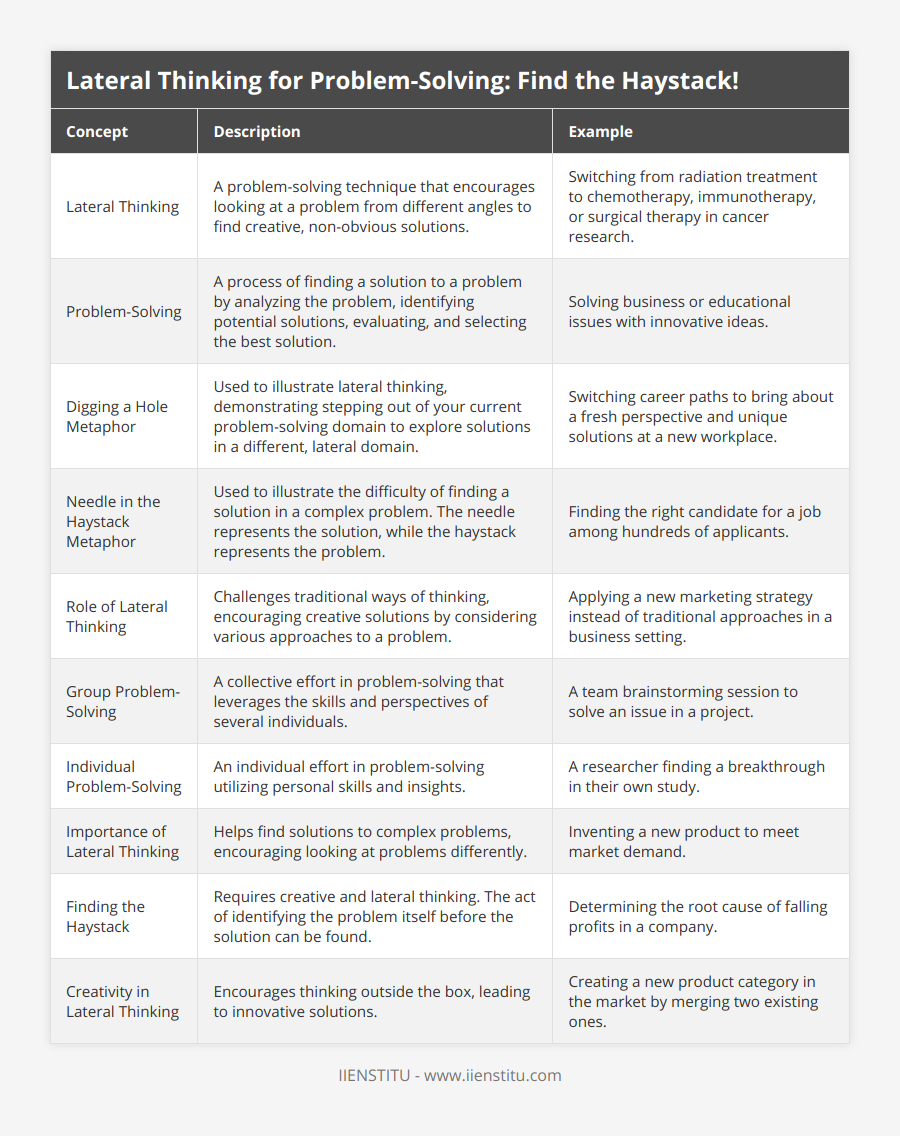
What is lateral thinking and how can it be used to solve problems?
Lateral thinking is a problem-solving approach that encourages creativity and divergence from conventional solutions. It involves looking at a problem from different angles, questioning assumptions, and seeking to identify non-linear solutions. It is a valuable tool for problem-solving, as it enables us to find new ways of looking at the same problem and uncovering solutions that may not have been considered previously.
Edward de Bono first coined the term lateral thinking in 1967; it has become an essential part of problem-solving. It is based on the idea that there may be multiple solutions to a problem and that we should be open to exploring unusual or unconventional ideas. It is often used to break out of the “box” of conventional problem-solving and to open up new possibilities.
Lateral thinking can be applied to any problem-solving situation, from personal to business challenges. It involves looking at the problem from different perspectives, questioning assumptions, and searching for solutions outside the standard “box.” It encourages divergent thinking and encourages us to think “outside the box”.
Several techniques can be used to apply lateral thinking to problem-solving. These include brainstorming, mind mapping, and forcing relationships. Brainstorming involves coming up with as many ideas as possible without judging them and then narrowing them down to the best solutions. Mind mapping involves visualizing the problem and looking for ways to connect the different elements. Forcing relationships involves forcing relationships between elements to uncover new solutions.
Lateral thinking can be a powerful tool for problem-solving. It encourages us to think outside the box and develop creative solutions. It can be used in any problem-solving situation, from personal to business challenges. By applying these techniques, we can uncover new solutions and possibilities.
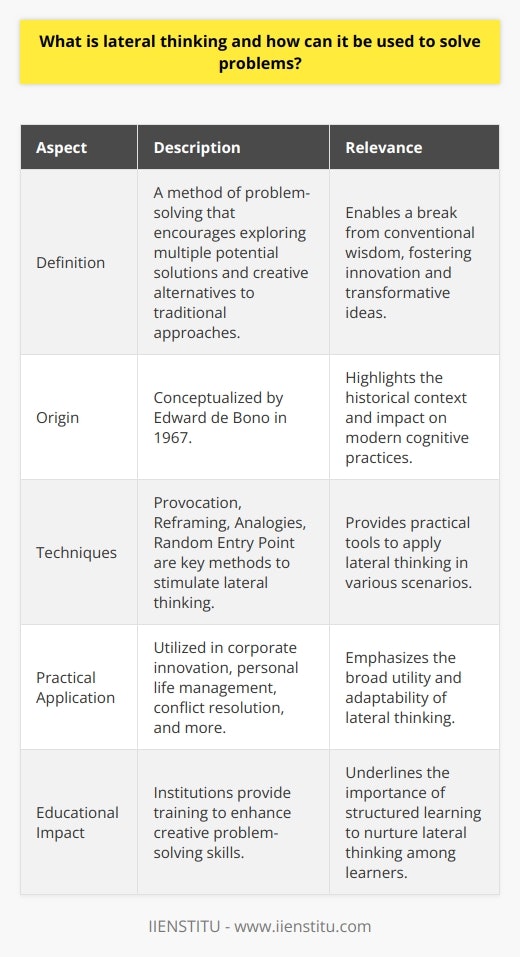
What are the benefits of using lateral thinking for problem-solving?
Lateral thinking is a problem-solving method that encourages creative and unconventional solutions to problems. It is a valuable tool that can be used to help think outside the box and come up with innovative solutions to complex problems. This article will discuss the benefits of using lateral thinking for problem-solving.
One of the main benefits of using lateral thinking for problem-solving is that it encourages creative and innovative solutions. By challenging the traditional ways of thinking and approaching problems, lateral thinking allows for a more excellent range of potential solutions. Furthermore, lateral thinking encourages creativity, which can be beneficial in many aspects of life.
Another advantage of using lateral thinking for problem-solving is that it can help to break down complex problems into more straightforward tasks. Breaking down a problem into smaller components makes it easier to identify the underlying cause and develop a more effective solution. Furthermore, lateral thinking can also help identify potential solutions that may not have been considered.
In addition, lateral thinking can help reduce the time required to come up with a solution. Considering a range of potential solutions can lead to a more efficient problem-solving process. Furthermore, lateral thinking can help to identify the most effective solution in a shorter amount of time.
Finally, lateral thinking can help to foster collaboration and teamwork. By considering a range of potential solutions, it can be easier to identify which solution is the most effective, leading to a better outcome. Furthermore, lateral thinking can help to stimulate discussion among team members and lead to a more productive problem-solving process.
In conclusion, lateral thinking can be a valuable tool for problem-solving. It encourages creative and innovative solutions, helps to break down complex problems into more straightforward tasks, reduces the amount of time required to come up with a solution, and fosters collaboration and teamwork. Therefore, it is a valuable tool that can be used to help solve complex problems.
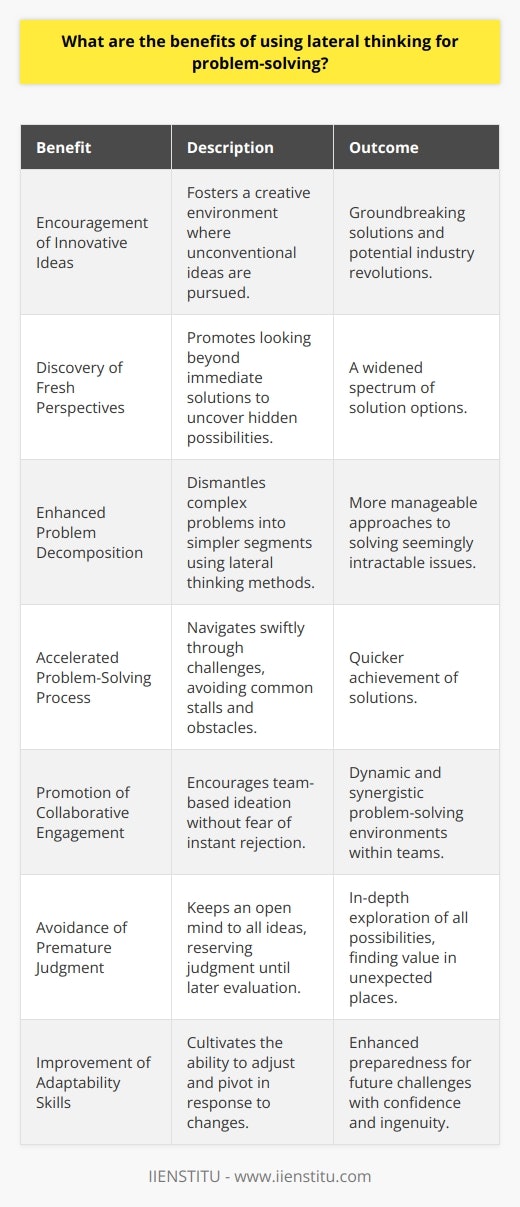
How can lateral thinking help to find the needle in the haystack?
Lateral thinking is a problem-solving technique involving thinking outside the box to find creative solutions to complex problems. It is often used to find the proverbial “needle in the haystack”; that is, to find a solution to a problem when all other avenues have been exhausted. In this article, we will explore how lateral thinking can be used to find the needle in the haystack.
At its core, lateral thinking is about asking questions from different perspectives. This can be done by breaking down the problem into its parts and looking for fresh ways to approach it. This could involve exploring the problem differently or looking for connections between seemingly unrelated concepts. By doing this, we can often uncover new solutions and ideas that have gone unnoticed by traditional problem-solving techniques.
For example, when trying to find the needle in the haystack, lateral thinking could involve asking questions like: Are there any patterns in the haystack that could help us identify the needle? Is there a way to use technology to detect the needle? Could we use a magnet to find the needle? We can help uncover hidden solutions that could lead to the needle by asking questions like these.
In addition to asking different questions, lateral thinking encourages us to think creatively. We can use our imagination to develop creative solutions to help us find the needle. For example, we might devise an idea to use a metal detector to find the needle or an algorithm to analyze the haystack and identify patterns that could lead to the needle.
Finally, lateral thinking can help us to look at a problem from a different perspective. This means we can look for new ways to approach the problem and find solutions that we may have overlooked. For example, if we were trying to find the needle in the haystack, we might ask ourselves, “What would a bird see if it were looking for the needle?” We can help uncover creative solutions and ideas that could lead to the needle by asking questions like this.
In conclusion, lateral thinking can be a powerful tool for finding the needle in the haystack. By asking different questions and thinking creatively, we can uncover new solutions and ideas to help us find the needle.
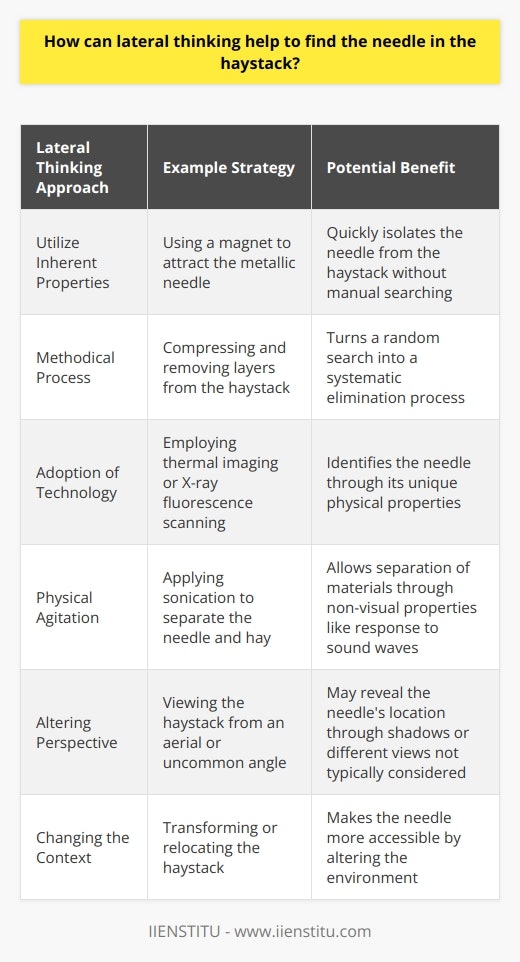
What are the 4 principles of lateral thinking?
Understanding Lateral Thinking Lateral thinking is a problem-solving approach that encourages creative and out-of-the-box solutions. Developed by Edward de Bono in the 1960s, it encompasses four primary principles: recognizing dominant ideas, searching for alternatives, challenging assumptions, and generating innovative solutions. Recognizing Dominant Ideas The first principle emphasizes understanding existing thought patterns and identifying the dominant ideas that govern our way of thinking. By discerning the prevailing perspectives, we can better recognize the limitations they impose and seek to overcome them through alternative means. Searching for Alternatives Secondly, lateral thinking encourages individuals to actively search for multiple alternative solutions instead of settling for the most obvious one. This broadens our understanding of the problem and increases the likelihood of discovering a more effective or creative solution. Challenging Assumptions The third principle involves questioning established assumptions and conventional wisdom. Lateral thinkers do not take existing beliefs and norms for granted; instead, they challenge and scrutinize them, opening up new possibilities and paths of exploration. Generating Innovative Solutions Lastly, the essence of lateral thinking encompasses the creation of innovative and unconventional solutions. By applying the previous principles, lateral thinkers are able to generate unique and out-of-the-box ideas by connecting seemingly unrelated concepts, thus breaking free from traditional mental constraints. In conclusion, lateral thinking principles can greatly expand an individual's problem-solving capacity by promoting creativity and innovation. By recognizing dominant ideas, searching for alternatives, challenging assumptions, and generating innovative solutions, lateral thinkers can overcome conventional limitations and unleash their full intellectual potential.
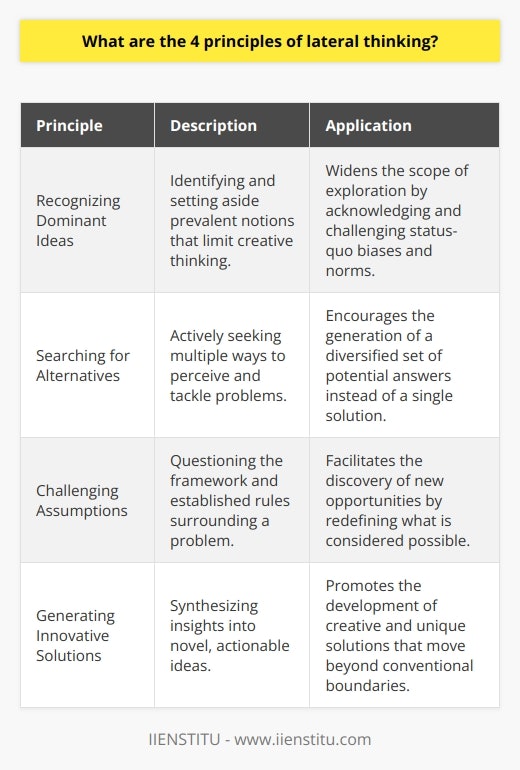
What are the 5 methods of lateral thinking?
Five Methods of Lateral Thinking **1. Random Entry Method** The random entry method is an essential lateral thinking technique where a seemingly unrelated word or idea is introduced into the problem-solving process. By incorporating this disconnected concept, individuals can break free from conventional thinking patterns and develop innovative solutions. **2. Provocation and Movement** In this strategic approach, intentional provocations are employed to challenge traditional thinking and assumptions. Once a provocative statement has been introduced, individuals move forward by identifying the valuable aspects of the idea, using this innovative perspective to generate unique solutions. **3. Challenge Existing Assumptions** Lateral thinking involves questioning the status quo and examining the underlying assumptions that may hinder creative problem-solving. By challenging these assumptions, individuals can remove constraints and explore alternative perspectives, fostering innovation and adaptability. **4. Concept Extraction** This method focuses on identifying the core concepts of a problem and considering them separately from the prevailing context. By extracting these essential elements, individuals can reconstruct the problem or situation while encouraging out-of-the-box thinking and fostering novel approaches to problem-solving. **5. Alternate Outcomes** The alternate outcomes method encompasses imagining different endings or results for a given situation. By considering various possibilities, individuals can gain new insights and perspectives, helping to facilitate creative thinking and enhanced problem-solving capabilities. In conclusion, lateral thinking constitutes a set of unique techniques to approach problem-solving from unconventional perspectives. By employing methods such as random entry, provocation and movement, challenging assumptions, concept extraction, and alternate outcomes, individuals can break free from traditional thinking patterns and generate innovative solutions. As a result, lateral thinking plays a crucial role in promoting adaptability and fostering creativity in academic and professional settings.
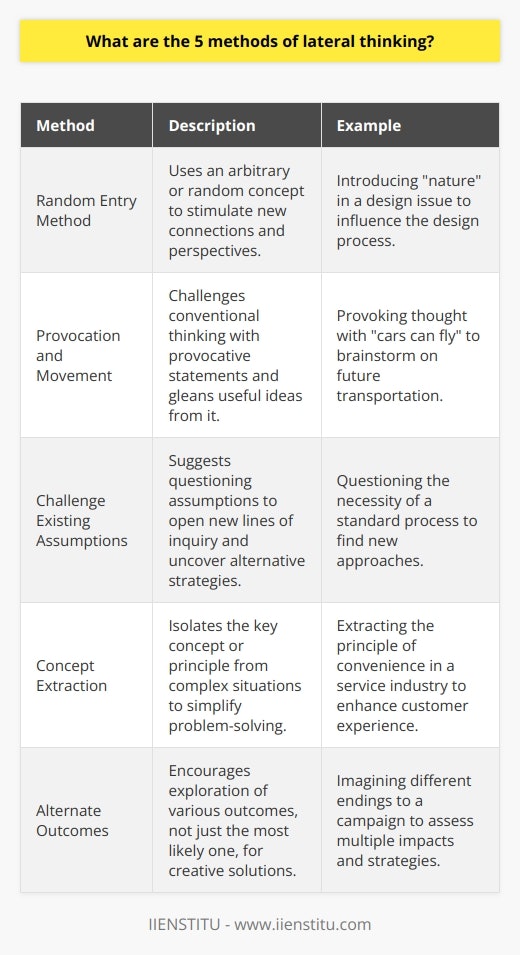
What is lateral thinking for problem-solving?
Understanding Lateral Thinking Lateral thinking for problem-solving is a creative approach that aims to generate innovative ideas and solutions by encouraging the thinker to look beyond conventional paradigms. This method contrasts with linear, logical, or vertical thinking, which focuses on progressing systematically and sequentially toward a solution. The Power of Divergent Thinking In lateral thinking, divergence is paramount. Individuals are encouraged to explore various possibilities, examining multiple alternatives, and generating unconventional ideas. Divergent thinking empowers individuals to challenge traditional assumptions, enhancing their ability to find innovative solutions tailored to the unique circumstances of a given problem. The Role of Provocation Provocation is a crucial technique in lateral thinking. It involves intentionally introducing an outrageous or irrational idea to disrupt established patterns, thereby opening the door for novel perspectives. Through provocation, individuals and teams are nudged away from their comfort zones and invited to examine issues from a fresh standpoint, allowing new ideas to flourish. Brainstorming and Ideation Brainstorming is an essential tool for encouraging lateral thinking. In a brainstorming session, participants are encouraged to propose as many ideas as possible, regardless of their perceived feasibility. The main goal is to create an open and supportive environment where individuals are free to express their thoughts without fear of judgment or criticism, thus fostering the development of original concepts. Random Input Technique One particularly effective lateral thinking technique is the random input method, where individuals incorporate unrelated elements into the problem-solving process. By juxtaposing disparate concepts or objects, practitioners can establish previously unseen connections, uncover hidden patterns, and gain new insights instrumental in resolving complex issues. In Conclusion Lateral thinking is a powerful tool for problem-solving, allowing individuals and teams to break free from established mindsets and explore diverse avenues. By embracing divergence, provocation, brainstorming, and random input, lateral thinkers can cultivate the innovative and flexible perspectives necessary for tackling complex challenges in an ever-evolving world.
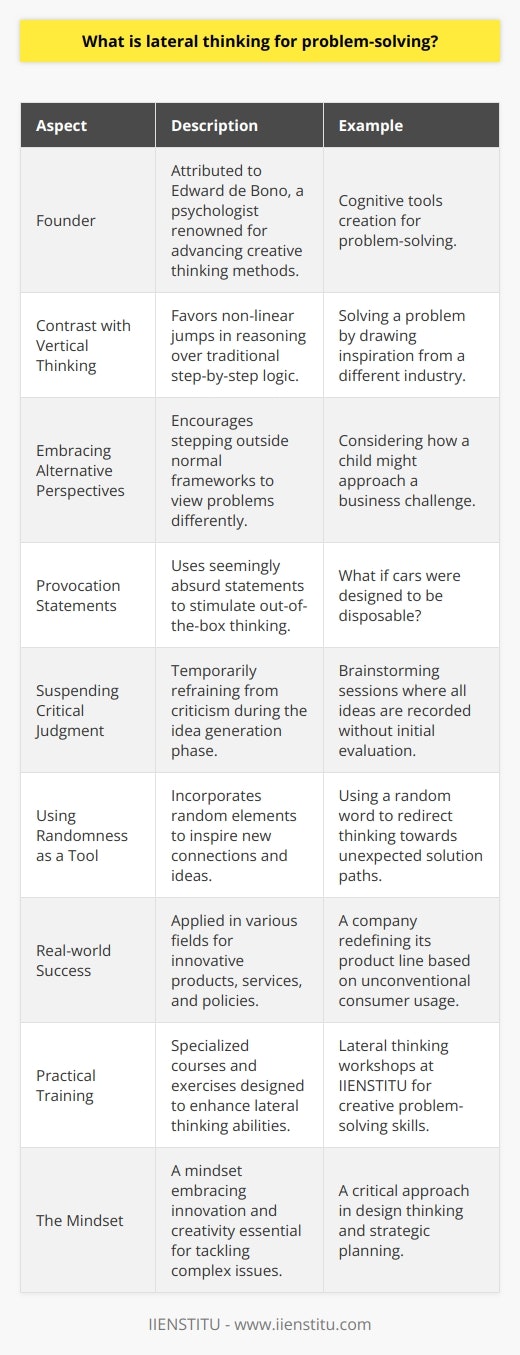
What is an example of lateral thinking problem-solving?
Example of Lateral Thinking Problem-Solving Application in Everyday Life An excellent example of lateral thinking problem-solving is the 'Nine Dots Problem.' This problem presents a scenario where you are asked to connect nine dots, arranged in a square grid of three rows and three columns, using only four continuous straight lines without lifting your pen or retracing any line. The problem essentially requires a change in perception and a creative approach to finding the solution. Overcoming Perceptual Boundaries The natural tendency when approaching this problem is to stay within the boundaries of the square formed by the nine dots. However, this approach proves unsuccessful in achieving the desired outcome. The lateral thinking required to solve the problem involves breaking mental constraints and extending the lines beyond the perceived boundaries. This demonstrates the importance of overcoming perceptual boundaries while employing lateral thinking techniques. Exploring Unconventional Approaches By extending the lines beyond the boundaries of the square, an individual explores unconventional approaches that might seem counterintuitive initially. The solution necessitates drawing three lines across the nine dots that go beyond the boundaries of the square and then a fourth line that connects the remaining dots. This method showcases the effectiveness of exploring unconventional approaches for problem-solving using lateral thinking skills. Developing Cognitive Flexibility Applying lateral thinking to the Nine Dots Problem allows individuals to develop cognitive flexibility. The ability to adapt and shift one's problem-solving perspective is an essential skill in the constantly changing landscape of the modern world. By approaching problems from different angles and questioning conventional wisdom, individuals become better equipped to manage complex and convoluted situations that require innovative solutions. Enhancing Problem Solving Techniques In conclusion, the Nine Dots Problem provides a clear illustration of lateral thinking problem-solving. By overcoming perceptual boundaries, exploring unconventional approaches, and developing cognitive flexibility, this problem-solving technique enhances the ability to tackle intricate and daunting challenges with innovative and creative solutions. Embracing lateral thinking fosters a mindset that enhances problem-solving techniques and leads to more effective outcomes in both personal and professional spheres.
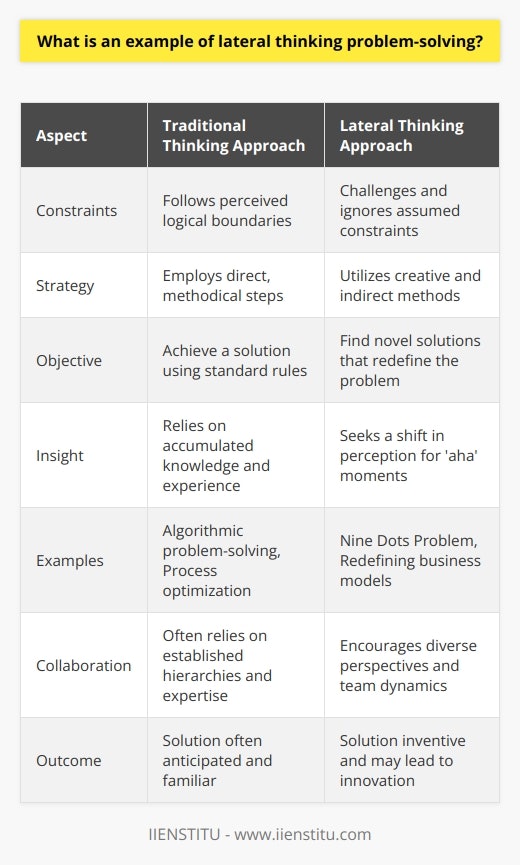
How can one develop a strong sense of lateral thinking to enhance problem-solving skills?
Cultivating Lateral Thinking Lateral thinking, a term coined by Edward de Bono, refers to a creative problem-solving technique that focuses on generating unique and innovative solutions through unconventional thinking. To develop a strong sense of lateral thinking and thereby enhance problem-solving skills, a variety of cognitive strategies can be employed. Brainstorming Diverse Ideas One effective method to boost lateral thinking is brainstorming, a practice that encourages idea generation across a wide range of perspectives without judgment. This process helps break free of linear thinking patterns and pushes the mind to explore new possibilities that could lead to unexpected outcomes. Using Analogies and Metaphors Analogies and metaphors are powerful tools for lateral thinking, as they help shift the focus from the immediate problem to analogous situations. This mental shift enables the exploration of similarities and differences between the problem and the analogy, often resulting in novel insights and approaches to the problem at hand. Adopting Beginner's Mind Embracing a beginner's mindset can aid in lateral thinking by promoting curiosity, openness, and a willingness to question assumptions. This mindset encourages individuals to approach problems with fresh eyes, free from the constraints of prior knowledge and preconceived notions that could otherwise impede creative thinking. Thinking in Reverse Reverse thinking or counterfactual reasoning turns a problem on its head by considering what should be done to achieve the opposite outcome. This approach stimulates lateral thinking by challenging the brain to recognize alternative avenues that may have been missed during traditional problem-solving practices. Assuming Constraints Introducing artificial constraints within the problem-solving process can foster lateral thinking by forcing the mind to consider alternative paths toward a solution. Limitations often spark creativity, as they require overcoming obstacles and exploring innovative approaches in order to reach a desired outcome. Connecting Unrelated Ideas Lastly, making connections between seemingly unrelated ideas or disciplines can lead to new perspectives and solutions. By actively pursuing such connections, one trains the brain to think laterally and uncover new ways of approaching problems. In conclusion, a strong sense of lateral thinking can be developed through various cognitive strategies, including brainstorming, using analogies, adopting a beginner's mindset, thinking in reverse, applying constraints, and connecting unrelated ideas. By incorporating these techniques into daily life, one can enhance problem-solving skills and foster creative thinking that pushes beyond conventional methods.

What is the role of lateral thinking in the modern problem-solving process?
The Role of Lateral Thinking Lateral thinking plays a crucial role in modern problem-solving processes by enhancing creativity and encouraging innovative approaches. It allows individuals to shift their perspective and view problems from different angles, leading to the generation of unique and effective solutions. Thinking Beyond Traditional Boundaries Lateral thinking, developed by Edward de Bono, is crucial for finding alternative solutions to complex problems, as it encourages looking beyond the known boundaries. This type of thinking helps break away from conventional patterns and leads to the formulation of inventive ideas that would not be discovered through traditional analytical methods. Promoting Creativity and Innovation By encouraging the exploration of alternative ideas, lateral thinking contributes significantly to enhancing creativity and innovation. Employing unconventional approaches, challenging assumptions, and considering seemingly unrelated factors results in new ideas and solutions. Consequently, lateral thinkers are often better equipped to handle complex problems in a rapidly changing world. Application in Various Fields The importance of lateral thinking is reflected in its application across various fields. For example, scientists utilize this approach to drive advancements in technology, while businesses employ it to develop unique products or services. Additionally, educators often incorporate lateral thinking techniques to foster students' creativity and problem-solving skills. Overcoming Limitations of Linear Thinking Linear thinking, the process of solving problems sequentially and logically, often leads to predictable solutions. While this approach has its merits, it can limit the ability to develop creative solutions. Lateral thinking enables problem-solvers to transcend these limitations and generate more unconventional ideas by encouraging non-linear, flexible, and divergent thinking processes. In conclusion, lateral thinking offers significant benefits in the modern problem-solving process by promoting creativity, innovation, and the ability to tackle complex issues from various perspectives. As our world becomes increasingly interconnected and multidisciplinary, incorporating lateral thinking into problem-solving will continue to be essential for driving progress and staying competitive in various fields.
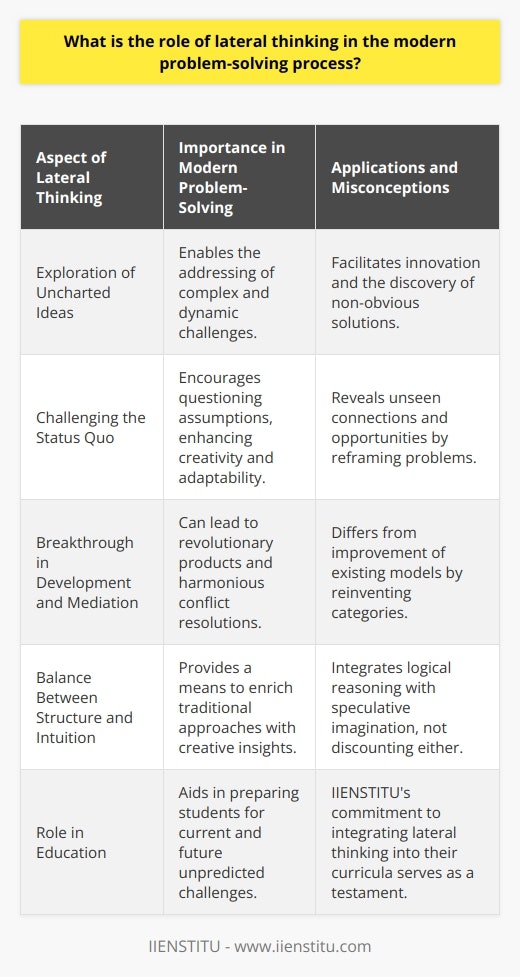
What are the 4 techniques for lateral thinking?
**Lateral Thinking Techniques** Lateral thinking, coined by Edward de Bono in 1967, refers to the process of generating innovative ideas by approaching problems from unique perspectives. To foster lateral thinking, researchers have identified four primary techniques: challenging assumptions, generating alternatives, searching for analogies, and random stimulation. **Challenging Assumptions** The first technique entails questioning and reevaluating established knowledge or beliefs. It encourages individuals to examine their preconceived ideas and to consider alternative perspectives. By challenging assumptions, individuals can break the constraints of traditional thinking, enabling them to identify innovative solutions to complex problems. **Generating Alternatives** Secondly, rather than settling for a single solution, lateral thinkers are encouraged to generate multiple possible solutions to tackle a given problem. By exploring various alternatives, lateral thinkers can evaluate the merits and drawbacks of each option, increasing the likelihood of identifying an optimal solution. This technique also fosters creativity and flexibility, essential traits for problem-solving. **Searching for Analogies** The third technique involves drawing parallels between seemingly unrelated contexts. Lateral thinkers can use analogies to transfer insights, solutions, or knowledge from one domain to another. This technique can yield innovative ideas that would not have been discovered if the problem were analyzed within its original context. **Random Stimulation** Lastly, random stimulation supports lateral thinking by providing an unexpected starting point for problem-solving. By introducing a random word, concept, or idea, individuals are forced to think outside their typical thought patterns, leading to novel connections and insights. Random stimulation can be achieved through various techniques, such as brainstorming, mind mapping, or using random word generators. In conclusion, the four techniques for lateral thinking – challenging assumptions, generating alternatives, searching for analogies, and random stimulation – serve as invaluable tools for fostering creativity and innovation. By employing these techniques, individuals and organizations can develop unconventional solutions to complex problems, ultimately contributing to their success in a rapidly evolving global landscape.
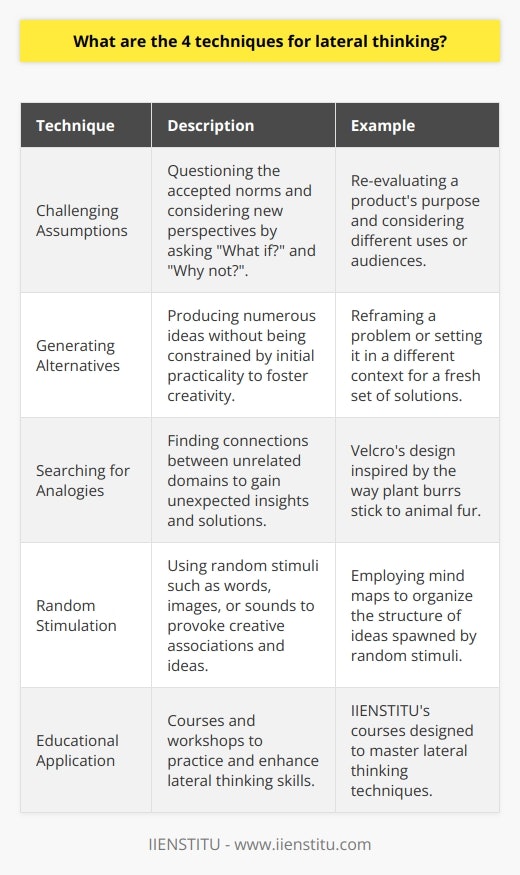
Defining Lateral Thinking Problem-Solving Lateral thinking is an unconventional approach to problem-solving that requires looking at a given issue from different angles or perspectives. By doing so, a person may discover unique and innovative solutions that are not possible through conventional linear thinking. Example of Lateral Thinking in Action A classic example of lateral thinking problem-solving is the 'nine-dot puzzle,' also known as the 'thinking-outside-the-box' puzzle. In this problem, a person is presented with nine dots arranged in a square grid and asked to connect all of the dots using only four straight lines without lifting the pen off the paper. Initial Constraints and Assumptions The challenge lies in breaking the perceived constraints and assumptions associated with the problem, which initially leads many people to think that the solution must be contained within the boundaries of the square grid formed by the nine dots. Overcoming Constraints Through Lateral Thinking Utilizing lateral thinking, one can overcome these constraints by questioning why the lines must end at the boundaries of the square grid. By allowing the lines to extend beyond the borders of the grid, it is possible to connect all nine dots using exactly four straight lines without lifting the pen off the paper. This solution exemplifies the core concept of lateral thinking - breaking free of limiting assumptions to uncover unique and innovative solutions. Real-world Application Lateral thinking problem-solving techniques can be applied in various real-world situations. For example, business managers can use such strategies to address tough organizational challenges, effectively utilizing resources, and increasing their company's competitive advantage. By embracing unconventional approaches, individuals and organizations can often find innovative solutions that bring significant and transformative impact. In conclusion, lateral thinking problem-solving involves challenging conventional thought patterns and exploring alternative solutions that may not initially appear logical. The nine-dot puzzle is a classic example of such a scenario where adopting lateral thinking principles can result in innovative and effective solutions. Lateral thinking is a valuable skill that can be applied in numerous real-world situations, driving advancements in various fields and industries.
What is lateral thinking in the problem-solving process?
Understanding Lateral Thinking Lateral thinking is a creative approach to problem-solving that involves considering diverse perspectives, synthesizing novel connections, and challenging traditional paradigms. In contrast to vertical thinking, which follows linear and logical patterns, lateral thinking provokes cognitive shifts by exploring unconventional ideas and presenting unexpected solutions. Role in Problem-Solving Lateral thinking plays a critical role in breaking away from rigid structures, enabling problem-solvers to generate innovative ideas and discover alternative paths. By disregarding preconceptions and embracing ambiguity, individuals and teams can expand their collective imaginative capacity and unlock new possibilities. Techniques for Lateral Thinking Various techniques can facilitate lateral thinking in the problem-solving process. These include provocations, random entry, concept mapping, and scenario planning. Practicing these methods can help individuals develop mental agility, question assumptions, and overcome cognitive biases. - Provocations: Deliberately introduce challenging or contradictory ideas to promote fresh thinking and stimulate novel associations. - Random entry: Identify unrelated concepts and explore the connections between them, often leading to unexpected insights. - Concept mapping: Visually represent relationships between seemingly unrelated ideas or concepts to reveal hidden patterns and links. - Scenario planning: Imagine a range of potential futures and consider how different variables might affect the outcome, fostering flexibility and adaptability in the decision-making process. Benefits of Lateral Thinking Utilizing lateral thinking in problem-solving can yield numerous benefits. Notably, this approach encourages adaptive thinking, fosters collaboration, and reduces mental rigidity. By cultivating an open-minded and flexible mindset, individuals and organizations can adapt to dynamic situations, cross-pollinate ideas across disciplines, and discover transformative solutions. In conclusion, lateral thinking is an essential component of the problem-solving process that promotes creativity and originality. By applying these techniques and adopting a curious and positive attitude, problem-solvers can better navigate complex challenges and uncover the innovative solutions necessary to drive progress and success in various fields.
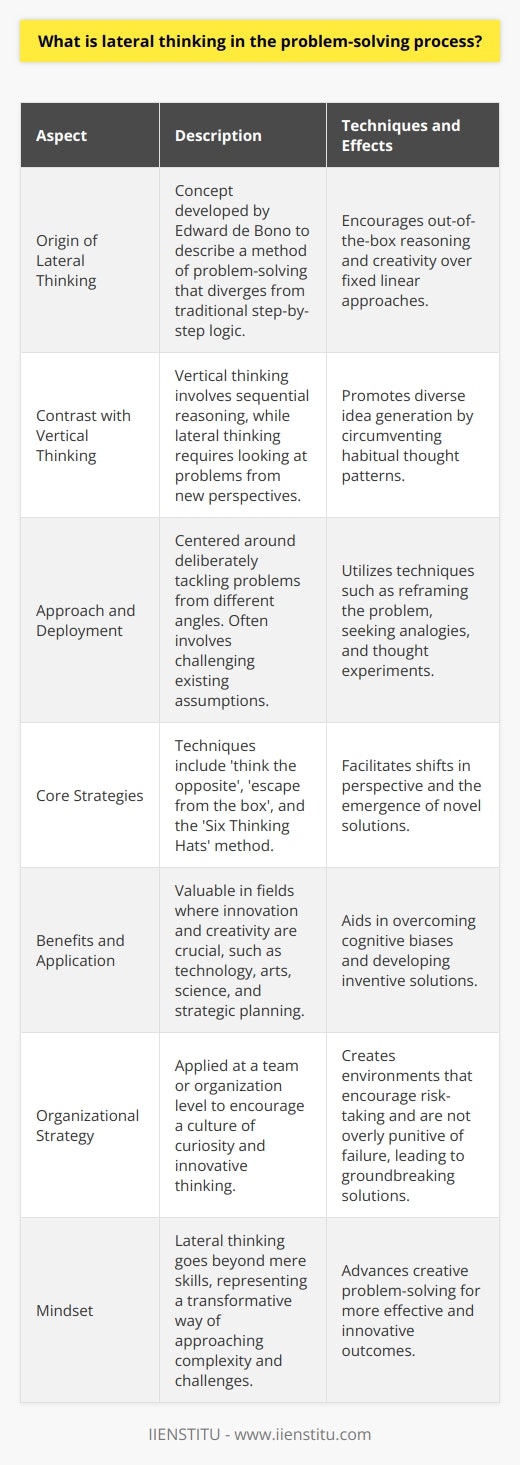
What are the key differences between lateral thinking and traditional problem-solving approaches?
Divergent Nature of Lateral Thinking The primary difference between lateral thinking and traditional problem-solving approaches lies in their divergent nature. Lateral thinking encourages generating multiple ideas, even if they might seem unrelated to the problem at hand. This process fosters creativity and originality by allowing for unconventional solutions without restricting oneself to predetermined categories or rules. Rigid Framework of Traditional Problem-Solving Contrastingly, traditional problem-solving approaches tend to follow a more rigid framework, involving clearly defined steps and logical thinking. Such a systematic process adheres to established guidelines and known principles, limiting the scope for creative exploration. Consequently, this can lead to less innovative results, as the problem is resolved through familiar solutions that adhere to predetermined boundaries. Breaking Patterns with Lateral Thinking Another key difference between lateral thinking and traditional problem-solving approaches is the former's emphasis on breaking patterns and reframing perspectives. Lateral thinking thrives in challenging conventional wisdom, reformulating problems, and recognizing novel connections to facilitate creative thinking. In doing so, it encourages individuals to venture beyond the realms of existing assumptions, offering fresh insights and better alternatives. Analytical Focus in Traditional Approaches However, traditional problem-solving methods typically center on an analytical focus, dissecting the issue into manageable components, and employing logical reasoning to reach the desired outcome. While methodical analysis has its merits, it can sometimes impede creative thinking, rendering the approach less effective in addressing complex, ambiguous, or unprecedented problems that demand unconventional solutions. Importance of Context Finally, the efficacy of lateral thinking and traditional problem-solving approaches largely depends on the context of the problem. Lateral thinking proves exceptionally advantageous in addressing ill-defined, novel, or highly complex problems that demand creativity and adaptability. Conversely, traditional problem-solving methods are well-suited for well-structured, process-driven problems where established principles and logic-based reasoning can deliver precise solutions. In conclusion, the key differences between lateral thinking and traditional problem-solving approaches stem from their divergent nature, varying methodologies, and context-dependency. Combining both approaches can foster a comprehensive, multidimensional problem-solving process, enabling the resolution of diverse challenges by leveraging the strengths of lateral thinking and traditional methods.
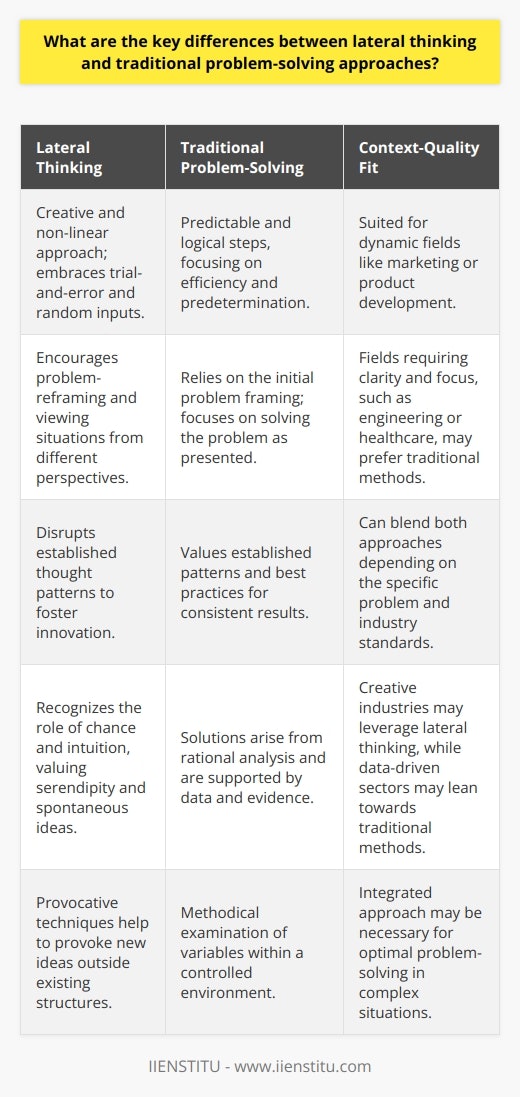
How does the use of lateral thinking impact decision-making processes in various fields such as business, science, and education?
Impact on Business Decision-Making The use of lateral thinking in business decision-making fosters innovation by challenging conventional wisdom and assumptions. This creative problem-solving approach empowers organizations to generate novel solutions, stay competitive, and adapt to changing market conditions. By encouraging divergent thinking, lateral thinking enhances decision-making by taking into account multiple perspectives, thus reducing the risk of potential blind spots and biases. As a result, business leaders can make more informed and effective decisions that lead to better outcomes. Influence on Scientific Endeavors In the realm of science, lateral thinking plays an essential role in advancing knowledge and driving new discoveries. The process of lateral thinking encourages scientists to think beyond the traditional boundaries of their fields and explore different possibilities. This fosters interdisciplinary collaboration and cross-pollination of ideas, enabling researchers to break new ground and challenge the status quo. Moreover, lateral thinking allows scientists to consider alternative hypotheses, thereby strengthening the deductive reasoning process and reducing the likelihood of confirmation bias. Ultimately, this leads to more accurate and comprehensive results in the scientific decision-making process. Contribution to Educational Practices Lateral thinking also has significant implications for education, as it promotes critical thinking and cultivates a culture of lifelong learning among students. By incorporating lateral thinking techniques into teaching practices, educators can help students develop flexible, adaptive, and divergent thinking skills essential for navigating the complexities of the modern world. This involves encouraging learners to question assumptions, analyze different perspectives, and tackle problems from various angles. In turn, this enriches the decision-making process in education as students become more adept at evaluating information, considering alternatives, and making well-rounded choices – both inside and outside the classroom.
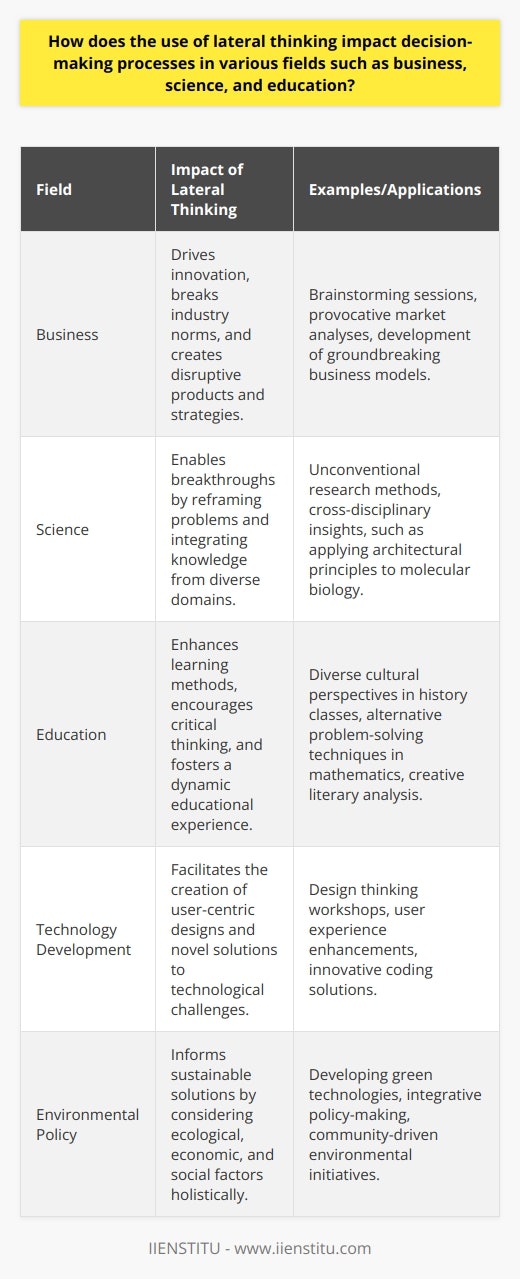
How can one encourage and foster an environment that supports lateral thinking in a team or organizational setting?
Fostering an Environment for Lateral Thinking To encourage and foster an environment that supports lateral thinking in a team or organizational setting, several key strategies and best practices should be put in place. Culture of Openness and Collaboration Firstly, cultivating a culture of openness and collaboration is essential, as it enables team members to feel comfortable expressing new ideas and making connections between seemingly unrelated subjects. This can be achieved by creating safe spaces for brainstorming, promoting active listening, and valuing all contributions equally. Encouraging Diverse Perspectives Another important aspect is encouraging diverse perspectives within the organization. A mix of backgrounds, experiences, and viewpoints can lead to more creative problem-solving and innovative thinking. This can be done by actively recruiting and promoting employees from varying industries, cultures, and disciplines. Embracing Failure and Iteration Embracing failure and iteration is critical, as well. Granting employees the freedom and flexibility to test out new ideas without fear of repercussions will embolden them to think outside the box more frequently. Celebrating failures as learning opportunities will ensure that your team is continuously evolving and improving. Providing Training and Tools To support lateral thinking, organizations should provide training and tools that specifically target creative thinking and problem-solving. This may include workshops, seminars, or online training programs that teach techniques such as mind mapping or idea-generation exercises. In addition, employees should be given access to resources and technologies that help facilitate collaboration and innovation. Setting aside Dedicated Time for Lateral Thinking Setting aside dedicated time for lateral thinking and brainstorming sessions is a practical way to ensure that these practices become an integral part of the work routine. Scheduling regular meetings or workshops focused on exploring new ideas can help to establish a culture of innovation and continuous improvement. Recognizing and Rewarding Creativity Lastly, organizations must recognize and reward creativity in order to foster an environment that encourages lateral thinking. By acknowledging and celebrating innovative ideas, leaders can demonstrate their commitment to a culture of creative problem-solving and encourage continued exploration and experimentation. In conclusion, fostering an environment that supports lateral thinking requires an intentional effort to establish a culture of openness and collaboration, embrace diverse perspectives, and provide resources and recognition that enable and incentivize creative thinking. By implementing these best practices, organizations can drive innovation, improve problem-solving, and stay ahead in a competitive marketplace.
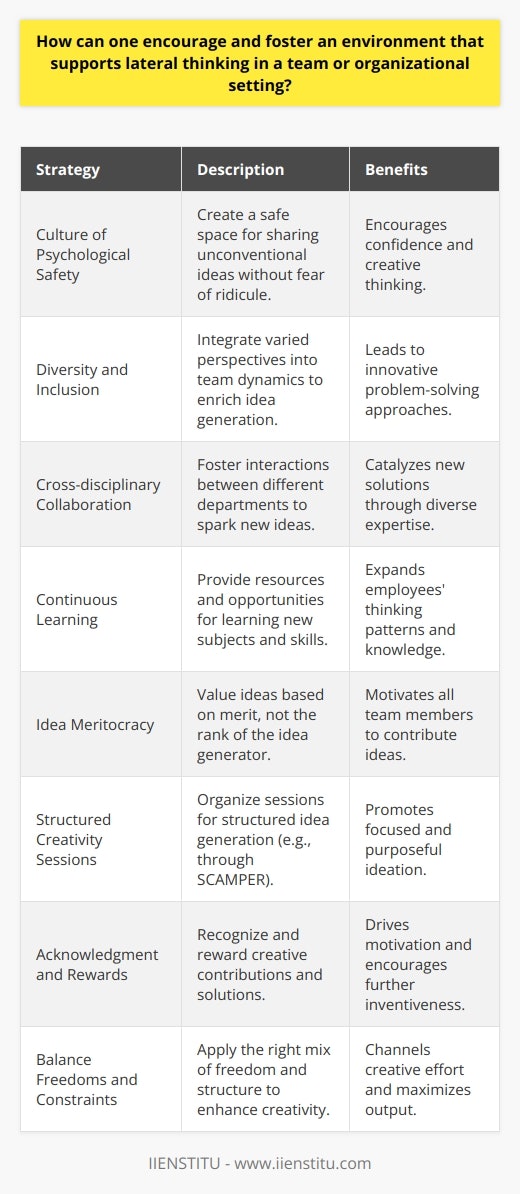
What is the process of applying lateral thinking techniques to real-world problems and what benefits can be expected?
Application Process for Lateral Thinking Techniques The process of applying lateral thinking techniques to real-world problems begins with the identification of the issue at hand, followed by the gathering of relevant information. Next, one should challenge the preconceived notions and assumptions surrounding the problem, allowing new perspectives to emerge. Generating Alternative Solutions Instead of pursuing linear and conventional approaches, an individual employing lateral thinking techniques should engage in creative brainstorming sessions to generate multiple alternative solutions. This can be facilitated by employing techniques such as analogies, random input, or related words. Logical Evaluation and Selection After generating numerous ideas, the individual must evaluate and select the most practical, logical, and effective solution. This requires critical analysis, comparison, and prioritization of the various alternatives, ensuring that the final choice addresses the problem efficiently. Implementation and Follow-up Upon selecting the most suitable solution, it is crucial to develop an action plan and execute it diligently. Monitoring the results of the implemented solution and adjusting it accordingly ensures continuous improvement and problem resolution. Expected Benefits of Lateral Thinking Utilization of lateral thinking techniques offers numerous benefits in addressing real-world problems. Firstly, it helps individuals to break away from entrenched thought patterns and look beyond the obvious solutions, thus fostering creativity and innovation. Enhanced Problem-Solving Skills Lateral thinking encourages the development of enhanced problem-solving skills, as it enables individuals to consider multiple angles and possibilities before arriving at a solution. This adaptive and flexible approach encourages out-of-the-box thinking, improving one's ability to tackle diverse issues. Increased Confidence and Adaptability By challenging conventional viewpoints and embracing new ideas, individuals enhance their self-confidence and adaptability in dealing with complex and unforeseen circumstances. Moreover, lateral thinking techniques foster collaboration and more effective communication, as they inspire people to be receptive to one another's thoughts and ideas. In summary, applying lateral thinking techniques to real-world problems involves a creative and systematic process that helps individuals generate innovative, effective solutions. By adopting such an approach, one can expect to develop improved problem-solving skills, increased confidence, and enhanced adaptability, all of which are essential for tackling the challenges of today's rapidly-evolving world.
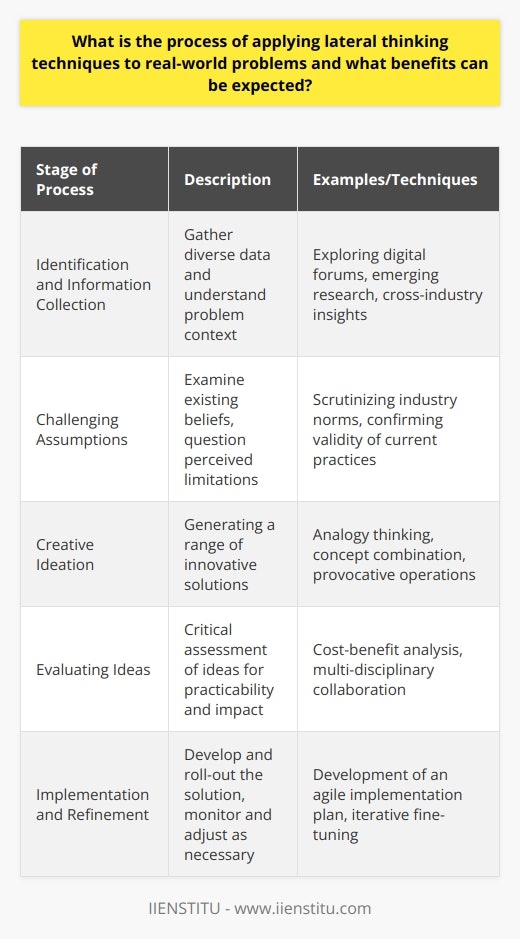
What are some effective strategies for incorporating lateral thinking into educational curricula and fostering creative problem-solving skills among students?
**Lateral Thinking Strategies in Education** Incorporating lateral thinking strategies into educational curricula offers numerous benefits for fostering creative problem-solving skills among students. One effective approach involves implementing brainstorming activities that allow students to think divergently and explore multiple solutions to a given problem. This method encourages open dialogue and collaboration among peers, stimulating cognitive flexibility and innovation. **Encouraging Diverse Perspectives** Another valuable strategy is promoting exposure to diverse perspectives and experiences, thus enriching students' intellectual growth. Teachers can incorporate multicultural texts and activities in their lesson plans, thereby nurturing empathy and cultural awareness while helping students develop their lateral thinking capabilities. Engaging students in discussions about multiple viewpoints provides opportunities to challenge assumptions and analyze problems from various angles. **Developing Critical Thinking Skills** A core component of lateral thinking is critical thinking skills. Educators can weave Socratic questioning techniques into classroom discussions, pushing students to critically evaluate their beliefs and assumptions. This process encourages students to approach problems analytically, identify potential pitfalls and biases, and create well-reasoned arguments. Consistently applying this method can result in students developing a habit of thinking outside the box. **Integrating Real-World Applications** Leveraging real-world scenarios and applications in educational curricula can significantly enhance students' ability to employ lateral thinking. Addressing real-life challenges in class encourages students to transfer their learning into practical contexts. Furthermore, incorporating interdisciplinary concepts allows students to explore new connections and see problems from different disciplinary lenses, which can stimulate the development of creative problem-solving skills. **Cultivating a Growth Mindset** Lastly, fostering a growth mindset in students is essential for nurturing lateral thinking. Encouraging a mentality that values constant learning and resilience helps students confront challenges with an open mind, build confidence in their creative problem-solving abilities, and develop adaptability in finding multiple solutions. Teachers should emphasize the importance of persistence and learning from failures, equipping students with the tools to handle complex real-world problems. By employing these strategies in educational curricula, educators can create an environment conducive to the development of lateral thinking and creative problem-solving skills among students. Consequently, students will be better equipped to navigate the complexities of the world and contribute innovative ideas to society.
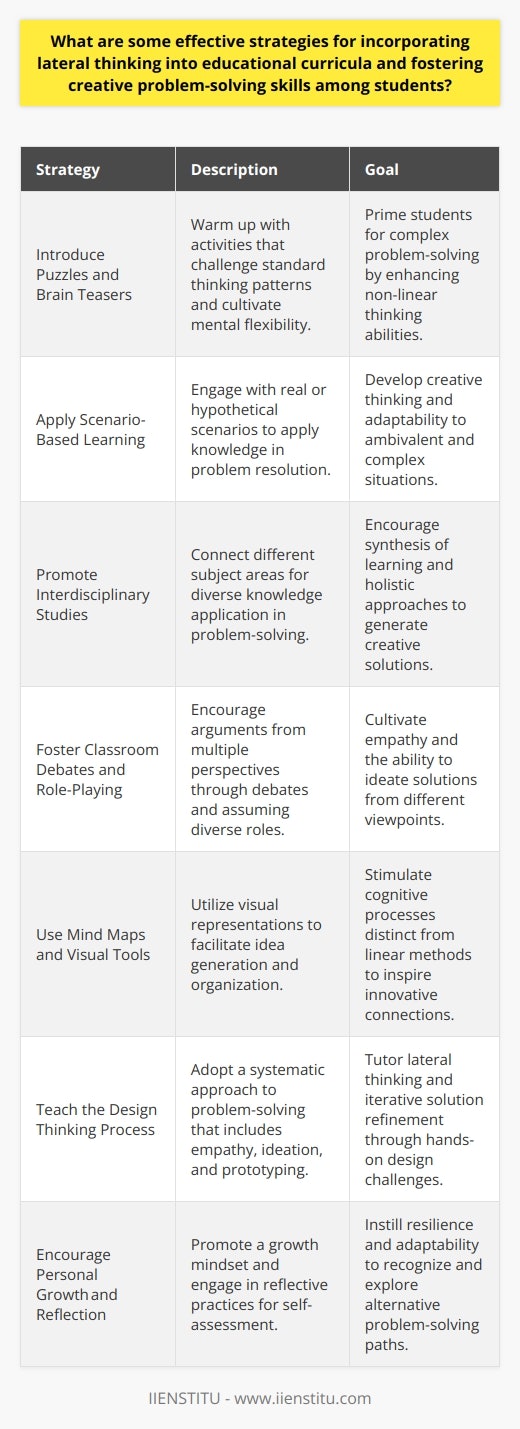
Can lateral thinking techniques be adapted and applied effectively across various cultures and industries, and if so, how can this be achieved?
Subheadings: - Lateral Thinking Across Cultures - Application in Diverse Industries - Possible Strategies for Implementation Lateral Thinking Across Cultures Lateral thinking, a method of problem solving that encourages unconventional approaches, can be effectively adapted across diverse cultures. The core principles of this method, including challenging assumptions and generating alternative ideas, can be universally applied to people from various backgrounds. Since different cultures possess unique perspectives, the application of lateral thinking can lead to innovative solutions that may otherwise be overlooked. Application in Diverse Industries Industries such as technology, healthcare, education, and business can also benefit from lateral thinking techniques. By fostering an environment that encourages creative problem-solving, organizations can stand out from their competitors and develop novel approaches to their respective fields. The implementation of lateral thinking across different industries may result in increased efficiency, improved products and services, and more satisfied customers and clients. Possible Strategies for Implementation One way to achieve the successful adaptation of lateral thinking techniques across various cultures and industries is through effective communication. First, practitioners must create an environment where ideas can be freely shared and valued without prejudice or judgment. Second, by incorporating cultural sensitivity and understanding the unique experiences of individuals from diverse backgrounds, organizations can access untapped sources of creativity. Training workshops tailored to different cultural contexts may be another effective strategy. By considering the unique challenges faced by each culture, these workshops would increase the likelihood of impactful results. Enhanced collaboration, both within and across industries, would encourage the exchange of ideas and foster innovation. In summary, lateral thinking techniques can be adapted and applied effectively across various cultures and industries, resulting in a myriad of benefits. With thoughtful implementation, these strategies can foster innovation, enhance collaboration, and support the development of groundbreaking solutions.
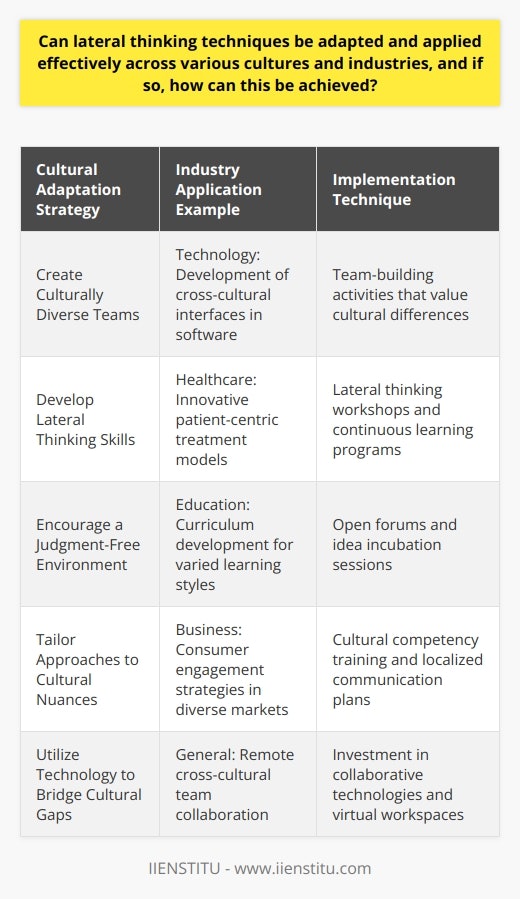
Yu Payne is an American professional who believes in personal growth. After studying The Art & Science of Transformational from Erickson College, she continuously seeks out new trainings to improve herself. She has been producing content for the IIENSTITU Blog since 2021. Her work has been featured on various platforms, including but not limited to: ThriveGlobal, TinyBuddha, and Addicted2Success. Yu aspires to help others reach their full potential and live their best lives.
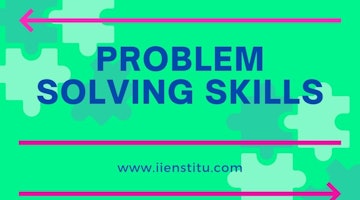
What are Problem Solving Skills?

3 Apps To Help Improve Problem Solving Skills

How To Improve Your Problem-Solving Skills

How To Become a Great Problem Solver?
Michael Muxworthy – Lateral Thinking Author
Disruptive creativity
Classic Puzzles 1 to 10
Classic lateral thinking puzzles with new twists – multiple original solutions – provocative clues – and a reader challenge to submit your own original answers.
The Elevator Lateral Thinking Exercise that Puzzles
(. . . with a twist)
A man living on the 30th floor of a high-rise building uses the elevator every day.
The man hates using the stairs, so he always catches the elevator all the way down to the ground level. However, when returning home, he usually gets out on the 24th floor and walks up the remaining stairs.
Clue – On rainy and wet days only, he catches the elevator all the way up to the 30th floor.
“It’s none of your business”
Answer – The man is a dwarf. On wet days he uses his umbrella to reach the 30th-floor elevator button.
Muxy’s Twist – The man is following the advice of his doctor who has told him he must exercise by climbing six flights of stairs every day. There is a leak in the stairwell making it unsafe to use the stairs on wet and rainy days.
Steven Murray’s Answer – The man has a secret mistress on the 24th floor that he likes to spend time with after work and before his wife gets home. He always walks from 24 to 30 to avoid running into anyone who might report the behavior to his wife. His wife is a dog walker, and so doesn’t walk the dogs on rainy days. The man, therefore, goes straight home to the 30th floor on wet and rainy days to avoid being found out.
Your original solution could be posted here.
– – – – –
Lateral thinking puzzle CHALLENGE
Submit your alternative answer to any lateral thinking puzzle using “comment” at the bottom of this page. if i think it’s good and original, you’ll receive full credit..
Exercise your lateral thinking creativity by finding new and original solutions
Lateral Thinking Puzzle of Survival
(With three very different answers)
A baby falls out of a window of a 20-story building … yet lives.
Clue – The baby’s mother jumped out of the same window after she saw her baby fall. She also survived.

“Remind me again WHY I choose to live in a high-rise building”
Answer – It was a ground-floor window.
Muxy’s Answer – The mother and baby were birds.
Susan Dunn – The baby and mother fell onto a window-cleaning platform that happened to be just outside at the time.
Technically, it’s not a lateral thinking puzzle unless it has more than one answer.
What is Lateral thinking?
This website will be soon promoting an entirely new concept … Lateral Thinking Fiction.
Check out the blurb for the first book (coming soon) HERE.
The Bus Stop Lateral Thinking Exercise in Creative Thinking
It is a cold, wet, wild, and stormy evening as a man drives along an open, rural, and exposed road. As he nears a bus stop, he notices that there are three people waiting:
- An old lady who is in urgent need of medical attention;
- His best friend who saved his life recently; and
- A wonderful girl that he had always wanted the opportunity to meet and ask out.
The man decides to stop and help, but his car only holds the driver and one passenger. He will not overload his car.
What does he do?
Clue – He achieves everything possible with this solution.
The man stops at the bus stop and gets out of his car. He says to his best mate “I know you are great at helping people. Please take my car and get this old lady to the hospital. I will catch the bus with this young lady and keep her safe until it comes”.
He makes a good impression with the young lady, helps his mate, and gets the old lady the help she needs.

“I’ve come to help … all of you!”
Answer – The man gives the keys to his best friend and asks him to drive the old lady to the hospital while he “bravely” keeps the company of the girl until the bus arrives.
Muxy’s Answer – Rather than risk moving the old lady, the man uses his considerable medical knowledge to administer immediate first aid with the help of the girl he wants to ask out. He sends his best friend to get help while he impresses the girl with his ability to take control.
Creative thinking is something that can be learned … and practiced.
Lateral thinking is a strategy to facilitate creative thinking using tools of disruption.
Fourteen free lessons, about two to three hours all up, and you will have the tools of disruptive creative thinking forever in your repertoire of life skills to call upon.
Click here to change your life for the better.
The Barman Lateral Thinking Puzzle … (with my alternative answer)
A man walks into a bar and asks for a glass of water.
The barman ducks behind the bar and emerges holding a gun. He points the gun at the man’s face and yells “BANG”.
The man smiles at the barman and says quite sincerely, “thank you”.
Clue – The man leaves happy and satisfied, without drinking any water.
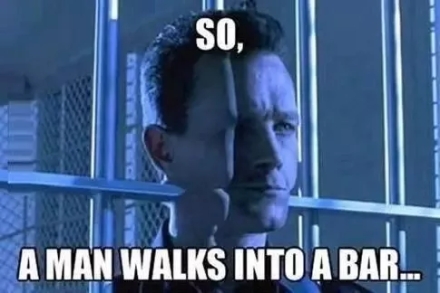
“Could I have a glass of water, please?”
Answer – The man had hiccups.
Muxy’s Answer – The man had recently run off with the barman’s wife. The barman had threatened to kill the man in a fit of rage. The man had gone into the bar to try to sort things out. The barman’s actions were his way of saying … “my rage is over”. LOL
– – – – –

“There’s no such thing as God!”
How lateral thinking took the heat out of this real confrontation might surprise you.
Click here to find out how
Lateral thinking bankruptcy puzzle … (with multiple answers).
A man pushes his car until he reaches a hotel, at which point he realizes that he is bankrupt.
Clue – This car wasn’t broken or out of fuel.
Answer – The man is playing Monopoly.
Muxy’s Answer – The man lives at the hotel. A finance company sent someone to repossess his car. He pushed the car in the hope that he can convince the agent of the finance company that the car is broken and isn’t worth the effort of repossessing. When he arrives at the hotel, the agent doesn’t fall for his ploy, and he is locked out of his hotel room unable to pay his bill.
The Death That Puzzles .
While walking across a large open field, you come across a man that has died very suddenly, unexpectedly, and only a very short time ago.
You look around but there is no one and nothing about except for an unopened package next to the man.
How did he die?
Clue – The man’s death was accidental.
“OOPS”
Answer – The unopened package was the man’s parachute.
Muxy’s Answer – The man was supposed to throw a package of vital medical supplies down to troops on the ground but slipped and fell.
Zed’s Answer – The man who died near an unopened package might have been stung by a bee and died from anaphylaxis before he could open the box containing his EpiPen.
Police Raid with a puzzling outcome.
Police are given a tip-off to the location of a man who just murdered someone. They don’t know what he looks like.
When they enter the room, they see a poker game in play between a carpenter, a truck driver, a fireman, and a mechanic. Without hesitation, they arrest the fireman.
How do they know that they’ve chosen correctly?
Clue – Equal opportunity
Answer – Only the fireman was a man, the rest were women.
Muxy’s Answer – The location was a “visitor area” at a jail. The fireman was visiting with three inmates, playing a friendly game of cards to enjoy their time together. They clearly didn’t have equal opportunity to commit the crime.
Creativity can be learned:
Creativity can be easily learned:, lateral thinking and creative management lessons.
Everything is absolutely FREE
The Locked Cellar Puzzles.
A woman was told to never open the locked cellar door or she would be in big trouble.
One day, she decided to force open the door. She then left, never to return, and went straight to the police station even though there was nothing unusual in the cellar.
Clue – She didn’t know if anyone would see her when she opened the door.

“You must never open this door”
Answer – The woman was being kept a prisoner in the cellar.
Muxy’s Answer – The woman was stationed as a security guard outside a bank’s underground vault. She succumbed to temptation but lost her nerve so turned herself into police.
Creativity shared with children is time well spent
Practice! Creativity is like most things … the more you practice, the better you get:
Lateral thinking exercises, the man who hanged himself puzzles.
There is a large empty shed with a dead man hanging from the middle of the central rafter.
The rope around his neck is eight feet long and his feet are two feet off the ground. The nearest wall is 20 feet away from the man. It is not possible to climb up the walls or along the rafters.
The man hanged himself.
How did he do it?
Clue – The floor is wet.

“He was just hanging there …”
Answer – The man stood on a large block of ice.
Muxy’s Answer – The rope is made from a material that shrinks when it gets wet.
A Lateral Thinking Puzzle of Twins.
A mother gave birth to two children within an hour of each other on the same day and year, but the children aren’t twins.
Clue – There can be several related answers.

Answer – They were triplets, or quadruplets, or . . .
Muxy’s Answer – The mother agreed to become a surrogate mother, but happened to fall pregnant at the same time.
What’s Your Answer? – (Have a try! More than 5,000 people a month will see your effort)
Go back to: New Puzzles 1 to 12
OR … keep going!
Classic puzzles 11 to 20 with new answers, puzzles 21 to 30, puzzles 31 to 40, brainteasing puzzles for kids, success results from good habits:, time management … for life, creativity … the end of your troubles, problem-solving.
Submit your alternative answers here:

- Copy shortlink
- Report this content
- Manage subscriptions
Lateral Thinking Problems
Topic: Strategic Thinking and Problem Solving
Empowerment Video: Strategic Thinking
Basic Supplies:
- Blank paper
- Writing utensil such as a pencil or pen
- One copy of the lateral thinking problems per student or another method to display them such as an overhead or whiteboard
Video Discussion:
Say, “Think of a recent problem that you solved. This could be a personal problem, a problem at school, or a problem at home.”
Ask, “How did you solve it?”
Give students a moment to think, then ask for any volunteers that are willing to share their problem and the solution.
Guide students to understand that there are many ways to approach and solve problems.
After watching the video “ Strategic Thinking ”, ask your students the following questions:
- What are some ways that you could try to solve a problem?
- Is there a “best” way to problem solve? Why or why not?
- Do you think one type of problem solving will work for all types of problems? Explain your thinking.
- Why do you think it’s important to be able to think strategically?
Activity Instructions:
Lateral thinking is one way to solve problems. Like all problem-solving strategies, the more you practice, the easier it will become. This type of problem solving can help you learn to “think outside the box” and ultimately become a stronger strategic thinker.
- Working alone or with a partner, work to solve each of the lateral thinking problems one at a time.
- Be prepared to share your answers and your thinking with the class!
Lateral Thinking Problems:
- You are standing next to three light switches. All three switches are now in the off position. You know these switches belong to three lights in another room, but you can’t see into the other room. You can do whatever you want with the switches, but when you are finished you must go into the other room and say which switch belongs to which bulb. You cannot enter the room more than once. What will you do to determine which bulb belongs to which switch?
- How can you divide a cake into eight pieces using just three cuts?
- A farmer is travelling with a fox, a goose, and a bag of beans. During his journey, he comes across a river. There is a boat tied to the shore that he can use to cross the river. The farmer can only fit one thing in the boat with him at a time. If left alone together, the fox will eat the goose, or the goose will eat the beans. How does the farmer get everything across the river safely?
- Your sock drawer only contains 18 white socks and 18 blue socks. How many times do you need to reach inside the drawer and take out a sock to guarantee a matching pair?
(Scroll down to see answers)
Lateral Thinking Answers:
- Answer: Turn on the first switch and wait for at least five minutes. Turn off the first switch and then turn on the second switch, leaving it on. Once you get into the other room, you’ll find the bulb for the second switch still shining, the bulb for the first switch will be hot, and the bulb for the third switch will be neither hot nor on.
- Answer: Cut the cake into four pieces using two cuts. Then move the four pieces so they align and cut the cake horizontally in half with your third cut, making eight pieces.
- Answer: The farmer brings the goose across the river first. Then, the farmer brings either the fox or the beans across. The farmer must bring the goose back to the original side of the river. The farmer brings the other item back (either the fox or the beans). The fox and the beans are now on the other side of the river. The farmer returns and brings the goose across the river again.
- Answer: Three times. On the third time, you’ll get either a white or a blue sock to match with one of the other two you’ve already grabbed.
*Lateral Thinking Puzzles Sourced from:
https://mumlyfe.com.au/mind-bending-lateral-thinking-puzzles-for-kids/ https://www.prodigygame.com/main-en/blog/brain-teasers-for-kids/
Privacy Overview
- International edition
- Australia edition
- Europe edition

Can you solve it? Are you a lateral thinker?
Finding creative solutions
UPDATE: To read the solutions click here
Sometimes it pays to approach a problem sideways. Each of today’s puzzles requires some lateral thinking, in that the first step of the solution is perhaps not the obvious one.
1. Three cloves on an orange
Given three points on the surface of a sphere, what is the probability there is a hemisphere on which they all lie?
2. A big number
If you multiply all the prime numbers less than one million together, what is the final digit of your answer?
[A prime number is a number that is divisible only by itself and 1, such as 2, 3, 5, 7, 11, 13, and so on.]
3. The three threes
Can you make 20 using three threes and any mathematical operations you like?
[i.e you need to find an expression that includes 3, 3 and 3, and no other digits, but may include any other mathematical symbol, such as +, -, x, ÷, (, ), √, ., etc. An example might be 3 √3 /3, although this would be wrong since it does not equal 20.]
4. Square are you?
How can you cut this figure into four pieces which can be reassembled to form a square?
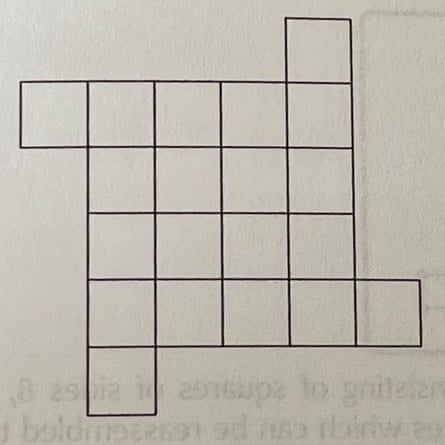
5. Roamin’ numerals
Make the equation valid by moving exactly two matchsticks

Please NO SPOILERS. I’ll be back at 5pm UK. Instead discuss your favourite examples of lateral-thinking.
UPDATE: To read the solutions click here.
All of today’s puzzle come from Des MacHale’s brilliant new book Lateral Solutions to Mathematical Problems , in which he presents more than a 100 problems from across the mathematical landscape whose solutions benefit from out-of-the-box thinking.
MacHale, emeritus professor at University College, Cork, is well known to readers of this column as an encyclopedia of mathematical humour . Hs latest book replaces the the “haha” with the “aha!”
(Hopefully, with not too much aaaaaaaargh! )
I’ve been setting a puzzle here on alternate Mondays since 2015. I’m always on the look-out for great puzzles. If you would like to suggest one, email me .
- Mathematics
- Alex Bellos's Monday puzzle
Comments (…)
Most viewed.
- Memberships
Parallel Thinking explained

Parallel thinking: this article explains the concept of parallel thinking in a practical way. The article starts with the definition of this term, followed by a general explanation and examples of situations in which this thinking style can be applied. You will also find an explanation of how you can apply parallel thinking in your personal life and what the benefits of this thinking style are. Enjoy reading!
What is parallel thinking?
Parallel thinking is a problem solving tool that has become very popular in recent years. Also known as lateral thinking , or Six Thinking Hats , the method involves looking at a problem from multiple perspectives to arrive at creative solutions.
Paralell thinking was developed by Edward de Bono , a renowned physician, psychologist and author. His technique is based on the idea that conventional or linear thinking hinders creativity and leads to an incomplete view of things. Parallel thinking encourages the user to approach problems from different angles, leading them to more innovative solutions.

Origin of parallel thinking
The concept of parallel thinking was first introduced in the 1985 book Six Thinking Hats . Before that, Edward de Bono had already established himself as an authority on creativity and innovation.
In Six Thinking Hats , Edward de Bono presented the idea that traditional thinking, in which individuals take opposing viewpoints and fight them out, often leads to unproductive and confrontational discussions.
Instead, he proposed a new approach. People have to put on different “hats” or modes of thinking to explore a problem from different angles.
The principles and process of parallel thinking
In his book, Edward de Bono elaborates on the principles of parallel thinking:
Focus on exploration
The primary purpose of parallel thinking, according to De Bono , is to explore a problem. Not to argue or defend different points of view. By focusing on exploration, people can work together to create creative solutions to complex problems.
Use the metaphor of the six hats
Parallel thinking requires the users to use the metaphor of six different hats representing six different modes of thinking. These modes include:
- White hats (facts and objective)
- Red Hats (emotional and intuitive)
- Black hats (critical and careful)
- Yellow Hats (optimistic and positive)
- Green Hats (creative and generative)
- Blue Hats (organizational and strategic)
One hat at a time
To ensure that everyone is on the same page, when using parallel thinking, individuals should wear a maximum of one hat at a time. This means that everyone in the group thinks in the same mode and focuses on the same aspect of the problem.
Respect and appreciation
Parallel thinking encourages respecting and appreciating each other’s ideas and points of view. By accepting and considering different points of view, individuals can work together to find creative solutions to complex problems.
Focused thinking
Parallel thinking is a structured thought process, meaning that individuals must follow a specific sequence of steps to explore the problem. This helps ensure that all aspects of the problem are considered and no important information is overlooked.
Focus on solutions
The ultimate goal of parallel thinking is to find creative solutions to complex problems. By exploring the problem from multiple perspectives and focusing on solutions, individuals can work together to find the best possible solution.
Example of parallel thinking in action in the workplace
Suppose a marketing team needs to come up with new ideas for an advertising campaign. Normally, the team would start by discussing a single idea one at a time. They discuss the pros and cons and then move on to the next idea.
This linear approach to thinking can be limiting, according to de Bono, because it values one idea over another and can hinder creativity and collaboration.
With parallel thinking, the marketing team would approach the brainstorming session differently. Instead of going through each idea one by one, they would first try to agree on the specific problem or goal they want to solve or achieve.
Then specific roles are assigned to each of the parts of the brainstorming session. These are the different hats talked about in the book “Six Thinking Hats”.
The team members would then each explore the problem from their assigned perspective simultaneously. For example, the devil’s advocate would argue against any idea, while the creative visionary would come up with bold and unconventional ideas. The practical problem solver would think about how to implement each idea in the real world.
While doing this, they share their thoughts and ideas with each other and they reinforce each other’s insights to refine their own thinking. By the end of the session, the team would have generated a wide range of ideas, which were explored from multiple angles.
This parallel approach to thinking can be very effective for marketing teams as it allows more creativity, collaboration and innovation in the brainstorming process.
How do I apply parallel thinking in my personal life?
Applying parallel thinking to your daily life can be a good way to develop your problem-solving skills. Here are some tips to get you started:
Identify the problem or decision you need to make
Start by identifying the problem you want to solve or the decision you need to make. This could be a personal or professional issue, a creative project, or anything else happening in your life.
Give yourself different roles
Once you’ve identified the problem, you’re supposed to assign different thinking roles to yourself. For example, you can take on the role of a “creative visionary” to generate new ideas. You can use the role of “practical problem solver” to think about the feasibility of the ideas. The “critical evaluator” role can be used to assess the strengths and weaknesses of each option. It is important that you do this in a disciplined way. It may take some practice to get better at this.
Explore every perspective
Take the time to explore each perspective one by one. You are supposed to look at the problem or decision from every angle.
Deepen every perspective
As you explore each perspective, you build on the ideas and insights you generate from each perspective. That can help generate new ideas and insights that you might not otherwise have considered.
Evaluate and select the best option
After exploring each perspective, evaluate the strengths and weaknesses of each option and select the best one. This may include reviewing each perspective to consider how each option fits into the broader context of the problem or decision.
By integrating parallel thinking into your daily life, you can become a more effective problem solver and decision maker and approach challenges with a more open and creative mindset.
Benefits of parallel thinking
Parallel thinking is a powerful tool that can help managers tackle problems and challenges in new and creative ways in business. By encouraging employees to consider multiple perspectives and ideas at the same time, parallel thinking enables them to explore a wide range of possibilities and generate innovative solutions to problems that arise in day-to-day work.
One of the main benefits of parallel thinking is that it can help reduce conflict and improve communication in group situations.
By encouraging all participants to explore ideas from multiple angles, parallel thinking can foster a collaborative and supportive environment where all contributions are respected.
Another benefit of parallel thinking is that it can help people overcome mental blocks and break old thinking patterns. By challenging employees to consider ideas that seem counterintuitive or unconventional, parallel thinking can open up new avenues of exploration and discovery that can help gain a competitive advantage .

Now It’s Your Turn
What do you think? Do you recognize the explanation about parallel thinking? Do you ever apply parallel thinking? Or do you have other methods to look at things from different perspectives? Do you have a favorite thinking style? Are you actively trying to prevent tunnel vision? Or do you easily go along with what is already on the table? Do you have other tips or comments?
Share your experience and knowledge in the comments box below.
More information
- Blelloch, G. E. (2009). Parallel thinking . In PPOPP (pp. 1-2).
- Cohen, M. D. (1981). The power of parallel thinking . Journal of Economic Behavior & Organization, 2(4), 285-306.
- De Bono, E. (2016). Parallel thinking . Random House .
- Peterson, T. O., & Lunsford, D. A. (1998). Parallel thinking: A technique for group interaction and problem solving . Journal of Management Education, 22(4), 537-554.
How to cite this article: Janse, B. (2023). Parallel Thinking (De Bono) . Retrieved [insert date] from Toolshero: https://www.toolshero.com/problem-solving/parallel-thinking/
Published on: 06/26/2023 | Last update: 06/26/2023
Add a link to this page on your website: <a href=”https://www.toolshero.com/problem-solving/parallel-thinking/”>Toolshero: Parallel Thinking (De Bono)</a>
Did you find this article interesting?
Your rating is more than welcome or share this article via Social media!
Average rating 4 / 5. Vote count: 4
No votes so far! Be the first to rate this post.
We are sorry that this post was not useful for you!
Let us improve this post!
Tell us how we can improve this post?

Ben Janse is a young professional working at ToolsHero as Content Manager. He is also an International Business student at Rotterdam Business School where he focusses on analyzing and developing management models. Thanks to his theoretical and practical knowledge, he knows how to distinguish main- and side issues and to make the essence of each article clearly visible.
Related ARTICLES

Albert Bandura biography, theory and quotes

David McClelland biography, books and theory

5 Stages of Grief by Elisabeth Kübler-Ross

Prospect Theory by Amos Tversky and Daniel Kahneman

Convergent Thinking: the Definition and Theory

CATWOE Analysis: theory and example
Also interesting.

Systematic Inventive Thinking (SIT)

Means End Analysis: the basics and example

Systems Thinking: Theory and Definition
Leave a reply cancel reply.
You must be logged in to post a comment.
BOOST YOUR SKILLS
Toolshero supports people worldwide ( 10+ million visitors from 100+ countries ) to empower themselves through an easily accessible and high-quality learning platform for personal and professional development.
By making access to scientific knowledge simple and affordable, self-development becomes attainable for everyone, including you! Join our learning platform and boost your skills with Toolshero.

POPULAR TOPICS
- Change Management
- Marketing Theories
- Problem Solving Theories
- Psychology Theories
ABOUT TOOLSHERO
- Free Toolshero e-book
- Memberships & Pricing
Advertisement
'Third Millennium Thinking': How to use scientific tools to solve everyday problems
Copy the code below to embed the wbur audio player on your site.
<iframe width="100%" height="124" scrolling="no" frameborder="no" src="https://player.wbur.org/hereandnow/2024/03/26/third-millenium-thinking-book"></iframe>
- Emiko Tamagawa
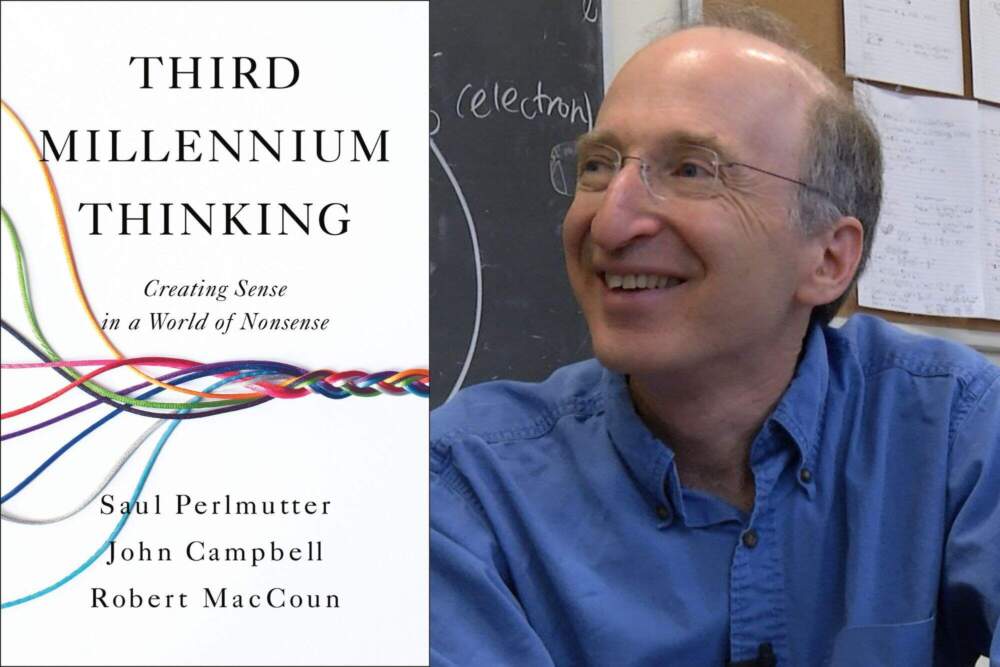
Life is full of decisions. “ Third Millennium Thinking: Creating Sense in a World of Knowledge ” outlines methods of making choices rationally using scientific methods.
Nobel Prize-winning physicist Saul Perlmutter , philosophy professor John Campbell , and social psychologist Robert MacCoun turned their course at the University of California Berkeley on using scientific tools to approach everyday problems into a book.
Perlmutter says it's easy to fall into mental traps or fool ourselves when making a choice. But when people assess all the variables that could influence them and the potential outcomes, they approach questions more thoughtfully, he says.
“There is so much of what is the scientific approach to the world that is never taught anywhere,” Perlmutter says. “It seemed like this was a time for us to be trying to figure out how can we teach this in ways that don't require having to become a scientist in order to do it.”
Book excerpt: 'Third Millennium Thinking: Creating Sense in a World of Nonsense'
By Saul Perlmutter, John Campbell and Robert MacCoun
INTRODUCTION
In just the past few decades, those of us who live in the internet-connected world have obtained access to a nearly unfathomable amount of information. We can click a link and instantly gain insight into whatever we’re curious about, whether it’s treatment options for a particular health condition, how to build a solar generator, or the political history of Malta. On the other hand, sometimes there is so much information we don’t know how to sort or evaluate it. The social science database ProQuest, for example, boasts of “a growing content collection that now encompasses . . . 6 billion digital pages and spans six centuries.” And that’s just old-school, print information! The Internet Archive’s Wayback Machine, an archive of websites and other digital artifacts dating back to 1996, hosts almost a trillion pages of digital content, tens of millions of books and audios, and nearly a million software programs.
More and more often, it can be hard to determine what to focus on, let alone how to distinguish what’s revelatory and enlightening, in and among all the highly technical, specialized, contradictory, incomplete, out‑of‑date, biased, or deliberately untrue information we can now access. Was that drug study funded by a pharmaceutical company? Did an AI system invent all those supposedly authentic product reviews? What do those statistics leave out? What does that article even mean ? It is also increasingly tricky to identify whom to trust for expert guidance in interpreting this information. There are all sorts of people out there who claim expertise — and perhaps your favorite experts aren’t my favorite experts. Experts disagree, or have ulterior motives, or perhaps don’t understand the world or “real life” beyond their own narrow perspective. How do we find an expert we can safely trust?
To make a sound decision, take a meaningful action, or solve a problem — whether as individuals, in groups, or as a society — we need first to understand reality. But when reality is not easy to discern, and we’re not sure which experts to trust to clarify the matter, we adopt other strategies for navigating the clutter. We “go with our gut”; decide what we “believe” and look for evidence to reaffirm whatever that is; adopt positions based on our affiliations with people we know; even find reassurance in belittling the people who disagree with us. We choose to consult experts who tell us what we like to hear; or bond in shared mistrust of people providing or communicating the information that confuses us, whether they are scientists, scholars, journalists, community leaders, policymakers, or other experts. These coping strategies may help us get by in our personal or professional lives; they may provide a consoling sense of identity or belonging. But they do not actually help us see clearly or make good decisions. And resorting to them can have dangerous social and political consequences.
How can we navigate better — as individuals, and as a society — in this age of informational overwhelm? How do we ward off confusion, avoid mental traps, and sift sense out of nonsense? How do we make decisions and solve problems collaboratively with people who interpret information differently or have different values than we do?
The three of us — a physicist (Saul), a philosopher ( John), and a psychologist (Rob) — have been working closely together for nearly a decade on a project to help our students learn to think about big problems and make effective decisions in this “too much information” age. We began our collaboration in 2011, in response to what was already a worrying trend toward no‑think, politics-driven decision-making. An issue like raising the national debt ceiling, for example, was being debated that summer as if it were a religious schism, rather than a simple, practical, probably even testable question of what economic approach would work best to improve the country’s economic well-being. Most of the arguments both yea and nay betrayed equal disregard for, or ignorance of, the most basic principles of scientific thought. We began to wonder whether it might be possible to first articulate and then teach the principles that would lead to clearer thinking, more rational arguments, and a more fruitful collaborative decision-making process.
The result was a team-taught, multidisciplinary Big Ideas course at UC Berkeley, intended to teach students the whole gamut of ideas, tools, and approaches that natural and social scientists use to understand the world. We also designed the course to show how useful these approaches can be for everybody in day‑to‑day life, whether working individually or collaboratively, in making reasoned decisions and solving the full range of problems that face us. To our great satisfaction, the course has been both popular and successful, and has since been replicated and adapted by other teachers at a growing number of other universities.1 Our students appear to rethink their worlds and emerge energized with new ways to approach both personal decision-making and our society’s problems. They are better able to investigate their questions, evaluate information and expertise, and work together as members of a group or a society. Inspired by their enthusiasm, we began to think about new ways to share these tools — and this new way of thinking and working together — beyond the classroom, with students and citizens of all ages.
We have become ever more concerned that our society is losing its way, causing suffering — and missing great opportunities — simply because we don’t have the tools that could help us make sense of the extraordinary amount of complex, often contradictory information now available to us. Practical problem-solving can come to a standstill when we cannot ascertain the facts of the problems, or, when those problems require communal or political solutions, even agree with others on what those facts are. We humans, who can figure out rocket science and fly to the moon, can’t always figure out how to navigate uncertainty and conflicting points of view to make a simple reasonable decision when we need to.
Part of the problem is that science itself is often a major source of the highly technical, opaque, inconsistent, and contradictory information that has overwhelmed, perplexed, and even angered people. Trust in science has eroded in the recent past.2 The achievements of science cannot live up to all the utopian expectations those successes have generated. Some scientific achievements have also come with negative social, political, or environmental side effects. For these and other reasons, science has become one of the totems of polarization in political discussions. In short, as science became harder to understand, was connected to undesirable side effects, and subjected to politically partisan critiques, many people lost their trust in scientists and in “science” itself.3
But science also has a phenomenal record of providing insight into — if not answers to — the most confounding questions humans have thought to ask. It has helped us to solve puzzles, address problems, and make better lives over millennia. It is a culture of inquiry rooted in the dawn of humankind, with centuries of practice in evaluating conflicting information in a baffling world, and in distinguishing what we know from what we don’t. Along the way, scientists have learned from both successes and mistakes, breakthroughs and blunders, to refine the tools with which to address new questions and solve new problems.
Over the past few years, we have all become aware of the shocking degree of polarization in our society, and the surprising interaction between this polarization and our society’s often-problematic relationship to science and scientific expertise. If we are to have any hope of finding the practical common plans and common understandings that can move our society ahead together, we need to learn to accept the possibility of errors in our own thinking, and our need for opposing views that help us see where we are going wrong. And we need to understand the source of the disenchantment with and backlash against scientific progress that arose during the end of the Second Millennium and seek to repair it.
No one book and no single approach can heal the rifts. Not all of our polarized disagreements will vanish. But we have to start somewhere. And we believe that one of our more promising starting points is with the culture of science — if we begin to borrow its tools, ideas, and processes, and make a Third Millennium shift in our own thinking.
Adapted from "Third Millenium Thinking" by Saul Perlmutter, John Campbell, and Robert MacCoun. Copyright © 2024 by Saul Perlmutter, John Campbell, and Robert MacCoun. Used with permission of Little, Brown Spark, an imprint of Little, Brown and Company. New York, NY. All rights reserved.
Emiko Tamagawa produced and edited this interview for broadcast with Todd Mundt . Grace Griffin adapted it for the web.
This article was originally published on March 26, 2024.
This segment aired on March 26, 2024.

Scott Tong Co-Host, Here & Now Scott Tong joined Here & Now as a co-host in July 2021 after spending 16 years at Marketplace as Shanghai bureau chief and senior correspondent.

Emiko Tamagawa Senior Producer, Here & Now Emiko Tamagawa produces arts and culture segments for Here & Now.
More from Here & Now

Only those with high IQ can spot Squid Game player with missing zipper in 40 seconds
I t's important to keep your brain active throughout the day - and one of the best ways to achieve this is by challenging yourself to a brainteaser. Brainteasers can help strengthen the mind as you're putting your lateral thinking skills to the test to work out a thinking puzzle, logic puzzle, or riddle.
So in anticipation of Netflix's announcement of a new season of Squid Game: The Challenge in 2024, the entertainment company VSO invites you to have a go at this tricky brainteaser, which challenges you to find the player with a missing zipper.
A statement reads: "The average person can answer in under 40 seconds - are you ready to put yourself to the test? If you spotted the missing zip in less than 40 seconds, you beat the average time taken to solve the challenge!"
According to Mindvalley , lateral thinking is a form of problem-solving that utilizes a more creative, less direct approach to the problem. A statement reads: "Analytical, logical problem-solving encourages vertical thinking, which is an approach we’re often taught when dealing with math equations. Lateral thinking is the indirect approach. It helps us view problems in an entirely new light. It helps us find unique, creative solutions we might never have before imagined.
Read more: Sign up to Mirror US's SMS updates for the latest straight from the newsroom
For all the latest on news, politics, sports, and showbiz from the USA, go to The Mirror US .
"The brain is neuroplastic, meaning it has the ability to shift and change over time. Many people believe our brains age as we do, growing less powerful, less capable, and less competent over time.
"What most don’t realize, however, is that you have the ability to manipulate your brain the way a sculptor molds clay. The brain is susceptible to all we expose it to—people, music, work— and even the physical environments we traverse on a day-to-day basis. Everything we partake in has the potential to subtly shift the wiring of our brain ."
If you're still playing along, you'll want to stop scrolling now as we're about to reveal the answer. For everyone else, here is the moment of truth...
The Mindvalley statement reads: "Ever heard of the phrase 'use it or lose it?' That’s quite literally true when it comes to the way our brains age. When we don’t actively seek novel experiences that expose our minds to all sorts of new and challenging stimuli, our neuroreceptors die off from disuse.
"Brain teasers can help keep the mind stimulated by encouraging it to think and act in new and novel ways. Lateral thinking keeps us feeling fresh, creative, and on our toes, so to speak, when tackling new problems. And we aren’t often given the opportunity to exercise lateral thinking in our day-to-day lives." If you're wondering how you didn't spot the dogs sooner, now might be a good time to try out a few more brainteasers . How did you get on? Let us know in the comments below.
Do you have a story to share? Email [email protected].
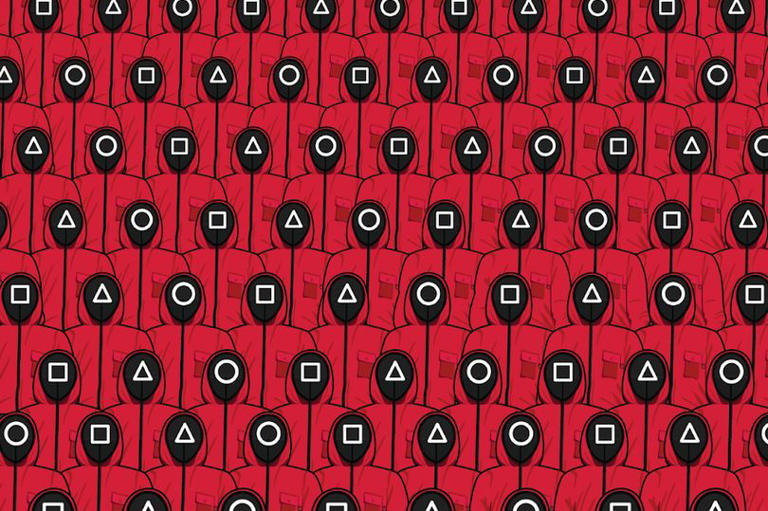
Aurora Beacon-News | Problem-solving, critical thinking on display…
Share this:.
- Click to share on Facebook (Opens in new window)
- Click to share on X (Opens in new window)
- Click to print (Opens in new window)
- Click to email a link to a friend (Opens in new window)
- Aurora Beacon-News Sports
- Aurora Beacon-News Opinion
- All Suburbs
Aurora Beacon-News
Aurora beacon-news | problem-solving, critical thinking on display at robotics event at aurora municipal airport.

Robots and the kids that built and operated them took center stage all day Friday at the Aurora Municipal Airport in Sugar Grove as 17 students 9 to 16 years old squared off in a competition during the first-ever Elite Robotics Camp, hosted by the U.S. Engineering League and the Wong Center for Education.
The Friday showcase was the culmination of a week-long camp program that included four days of workshops held at the Hampton Inn in Aurora.
A press release issued by the robotics camp said the 17 students involved spent time with a variety of national champions from multiple countries under Anthony Hsu of OFDL Robotics Lab Taiwan, “one of the world’s most accomplished coaches.”
Susan Mackafey, publicist for the Robotics group, said the event in Aurora came about as a result of the competitions that the Wong group hosts worldwide. William Wong, the founder of the Wong Center for Education, is the national organizer for the World Robot Olympiad, according to a press release.
“There were some students from Ukraine and Kazakhstan wondering if there would be any other kind of competitions as they wanted to hone their skills with one of the experts,” she said. “Will Wong ran with it, and has arranged the camp and the competition going on this Friday.”
Two of the camp members from Ukraine – Margo Proutorbva and Sofia Sova – were sponsored by the Wong Center for Education.
“It’s been an emotional trip for them,” Mackafey said, given the war going on in their homeland. “A lot of the kids are looking to train and do this as their careers and they love to compete. There are various levels of this competition that take place on a global scale.”
Local students were on hand as well, some of whom are being sponsored by the Wong Foundation, sources said.
Wong, of Naperville, was supervising Friday at the airport facility and said he started a robotics program with kids back in 2008.
“STEM has become a lot of the focus,” Wong said. “Even before I started, STEM was a big word. Engineering coding has always been there. It’s just how can we have kids do more of it. What’s happened is there are education companies like LEGO and other companies that have built robots that allow us to teach kids robotics in an easy fashion and we can create real world challenges off those robots so they literally are engineering, building and creating, designing and working with teams to have robots do tasks.”
Other than the collaborative learning, Wong said the biggest takeaways of the program “are problem-solving, figuring out how to make things work, a lot of trial-and-error, analysis and critical thinking.”
“There is teamwork, but the biggest is perseverance and working through the problems,” he said. “If the robot doesn’t work the first time or the second time or the 100th time, they are truly going through the engineering process – building, design and the whole cycle.”

Margo Proutorbva, 14, spoke about robotics and said through an interpreter she got interested in them two years ago.
“I’ve learned to assemble them,” she said. “The most difficult part of this has been when you assemble a robot with someone else – it’s way easier when you do it on your own. My robot can grab different objects, follow lines and turn in different ways.”
David Sharos is a freelance reporter for The Beacon-News.
More in Aurora Beacon-News

Aurora Beacon-News Sports | After winning nationals, Wisconsin-bound Patrick Hilby wants more for Aurora Central Catholic. ‘A prizefighter, man.’

Aurora Beacon-News | Task force meets to begin its work to look at impact of potential dam removal in St. Charles

Column: Oswego dad’s grief after loss of son leads to Ronald McDonald House and new book

Kane County Board votes against construction of new health department building
Trending nationally.
- Continuing Coverage: Key Bridge collapse in Baltimore
- Some of Florida’s sickest kids are losing Medicaid coverage on Easter Sunday
- Skiboky Stora, accused of attacking NYC TikToker, goes on unhinged rant in court
- White-collar crimes: Sam Bankman-Fried’s sentence is double Elizabeth Holmes’
- Conjoined twin, former TLC star Abby Hensel now married to Army veteran
Bias of Chicago Tribune

- Balanced News
- Story of the Week
- News Curation Principles
- Newsletters
- Balanced Search
Problem-solving, critical thinking on display at robotics event at Aurora Municipal Airport
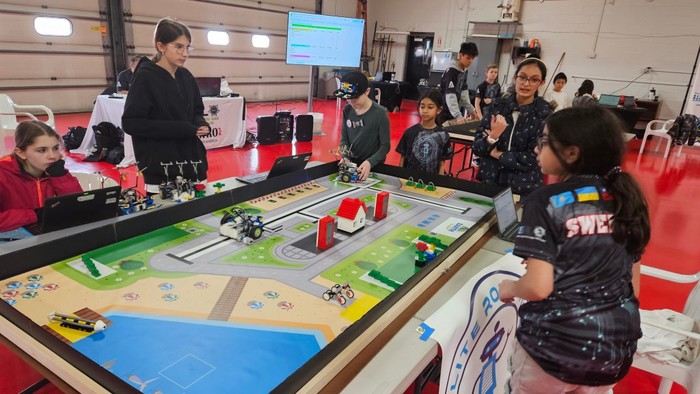
Robots and the kids that built and operated them took center stage all day Friday at the Aurora Municipal Airport in Sugar Grove as 17 students 9 to 16 years old squared off in a competition during the first-ever Elite Robotics Camp, hosted by the U.S. Engineering League and the Wong Center for Education. The Friday showcase was the culmination of a week-long camp program that included four days of workshops held at the Hampton Inn in Aurora. A press release issued by the robotics camp said the 17 students...
Chicago Tribune
Related Coverage

AllSides Picks

March 30th, 2024

Johnathon Held
March 29th, 2024

AllSides Staff
March 28th, 2024
More News about Culture from the Left , Center and Right
From the left, from the center, from the right.

IMAGES
VIDEO
COMMENTS
15. A man walks into a bar and asks the bartender for a glass of water. The bartender pulls out a gun and points it at the man. The man says, "Thank you" and walks out. Answer: The man had ...
Lateral thinking, sometimes called horizontal thinking or divergent thinking, is defined as an approach to problem-solving that strives for creative solutions rather than the most straightforward answer. Through spontaneous, free-flowing brainstorming, lateral thinking disrupts traditional step-by-step thinking patterns to develop as many ...
1 Lateral Thinking Tips to problem Solve. 1.1 Identify Self Limiting Beliefs. 1.2 Be Willing to Ask Questions. 1.3 Uses Puzzles to Spark Lateral Thought Processes. 1.4 Learn to Seek Multiple Alternatives to a Problem. 1.5 Make Use of the Random to Stimulate Innovative Solutions. 1.6 Take on a Different Perspective.
Lateral thinking refers to a person's capacity to problem solve by imagining creative solutions that cannot be figured out by deductive or logical solutions. Basically, it's thinking outside ...
Lateral thinking is a concept that psychologist Edward de Bono proposed in 1967. This process describes a person's ability to solve problems using thoughtful solutions beyond logical and deductive reasoning. In simple terms, this process refers to an individual thinking creatively to solve complex challenges.
The term "lateral thinking" was coined in 1967 by physician and inventor Edward de Bono, to describe a kind of out-of-the-box reasoning and critical analysis of scenarios that call for more than just typical step-by-step logic to solve. Lateral thinking is related to creative problem solving and critical thinking, all valuable skills to have, and […]
In essence, lateral thinking is a method of approaching a problem by deliberately forgoing obvious methods of reasoning. It requires one to consider a given issue from unlikely angles, uncovering ...
Lateral thinking is a problem-solving approach that involves looking at a problem or situation from different perspectives and coming up with creative and unconventional solutions. It's a type of thinking that encourages the use of imagination, creativity, and innovation to generate new ideas. Lateral thinking is often contrasted with ...
Understanding lateral thinking. Lateral thinking is a solutions-based series of techniques that help the user reframe a challenge or problem with a renewed or more creative perspective. Using new relationships and associations that are not always immediately present can help you change your perspective and identify emerging or new solutions.
Lateral thinking helps solve problems using creative and unconventional approaches. It breaks away from traditional methods. Brainstorming is a group activity where people contribute ideas without judgment to solve a problem. It generates creative solutions. Lateral thinking can be a solitary or group activity and it focuses on thinking ...
The definition and meaning of Lateral Thinking. Lateral thinking is defined by Oxford's Lexico as solving problems with "an indirect and creative approach, typically through viewing the problem in a new and unusual light.". But it's not just another buzzword. The concept of lateral thinking has been around for decades and it has a very ...
Lateral thinking. Maltese psychologist Edward de Bono (pictured in 2009) introduced the term "lateral thinking" in 1967. Lateral thinking is a manner of solving problems using an indirect and creative approach via reasoning that is not immediately obvious. It involves ideas that may not be obtainable using only traditional step-by-step logic. [1]
While lateral thinking takes a creative and indirect approach to solving problems, vertical thinking is more linear. It's used to solve well-defined problems that require a systematic and logical approach. Vertical thinking also involves analyzing information and following a structured path to reach a solution.
What Is Lateral Thinking? Lateral thinking foregoes the usual step-by-step approach to problem-solving and instead uses indirect and creative approaches to come up with solutions that aren't immediately obvious. In essence, it encourages you to think creatively, write down any ideas you come up with no matter how outlandish, and access ...
Lateral thinking—a term first coined by Edward de Bono in 1967—refers to a person's capacity to address problems by imagining solutions that cannot be arrived at via deductive or logical means.
The term lateral thinking refers to a problem-solving strategy that utilizes creative and indirect reasoning. We might colloquially call it "thinking outside the box.' Instead of relying on step-by-step analysis of the problem, the conventional method, lateral thinking often produces solutions that only seem obvious in hindsight.
The classic method for problem solving is logical or vertical thinking - coming to a conclusion by working through a step-by-step process using given information. Lateral or horizontal thinking involves having many ideas and looking at alternative ways of solving a problem by viewing the information in a broader sense.
Lateral thinking is about approaching a problem in a new and different way rather than following step-by-step like in the traditional process. Learn how you can adopt this mental model to solve your problem effectively. ... Explore how to apply system thinking when solving a problem n your organisation. M. Iswandi. 5 Feb 2023. ⚙️ Problem ...
Lateral thinking is a problem-solving technique that can help us find solutions to complex problems. In this article, we will discuss the definition of lateral thinking, its role in problem-solving, and the need for lateral thinking when finding the needle in the haystack. Definition of Lateral Thinking. Lateral thinking is a problem-solving ...
The Elevator Lateral Thinking Exercise that Puzzles. (. . . with a twist) A man living on the 30th floor of a high-rise building uses the elevator every day. The man hates using the stairs, so he always catches the elevator all the way down to the ground level. However, when returning home, he usually gets out on the 24th floor and walks up the ...
Lateral thinking is one way to solve problems. Like all problem-solving strategies, the more you practice, the easier it will become. This type of problem solving can help you learn to "think outside the box" and ultimately become a stronger strategic thinker.
Sometimes it pays to approach a problem sideways. Each of today's puzzles requires some lateral thinking, in that the first step of the solution is perhaps not the obvious one. 1.
Parallel thinking is a problem solving tool that has become very popular in recent years. Also known as lateral thinking, or Six Thinking Hats, the method involves looking at a problem from multiple perspectives to arrive at creative solutions. Paralell thinking was developed by Edward de Bono, a renowned physician, psychologist and author.
The cover of "Third Millennium Thinking" and author Saul Perlmutter. (Courtesy of Little, brown & Company and Jon Schainker) Nobel Prize-winning physicist Saul Perlmutter, philosophy professor ...
According to Mindvalley, lateral thinking is a form of problem-solving that utilizes a more creative, less direct approach to the problem.A statement reads: "Analytical, logical problem-solving ...
Problem-solving, critical thinking on display at robotics event at Aurora Municipal Airport. Students from 9 to 16 years old participated in the Elite Robotics Camp in Aurora which included a ...
301 Moved Permanently. openresty
Problem-solving, critical thinking on display at robotics event at Aurora Municipal Airport. Culture. Posted on AllSides March 30th, 2024. Save for Later . From The Center. Robots and the kids that built and operated them took center stage all day Friday at the Aurora Municipal Airport in Sugar Grove as 17 students 9 to 16 years old squared off ...